#The speed at which I am rotating them is unreal
Explore tagged Tumblr posts
Text

Oh boy oh boy oh boy looks who’s back :]
#Star’s Scribbles#Ship Kids#Jupiter But Not The Planet#Maroon#Ocs#Debating on adding their parents ship tags…#Anyways hiiiiiiii#UTMV#Almsot forgot that one#I’m back with art so I think that’s real neat#The speed at which I am rotating them is unreal
26 notes
·
View notes
Text
Developing the Experience
Angelique Shelley (MA Concept Art)
Blog Post #7
Sound
As production in After Effects continued, it became clear that it would make more sense for me to add and composite together the audio. The main reason for this is that the After Effects project file, complete with image sequences from Unreal added up to over 60GB so syncing that between team members could be problematic, especially since I am remote. There was also quite a lot of sickness in the group which I was fortunate enough to avoid.
Ana selected and shared some excellent sounds throughout the project for us to use.
We also received feedback from staff on how we should avoid just sticking sounds straight on but should pay attention to blend them together carefully.
I found that Premiere Pro was far more capable in the sound department than After Effects so exported the final composition from After Effects as an mp4 with a manageable file size that could render in real time in Premiere Pro. To avoid double-compression by encoding to mp4 twice though I decided to edit the sounds over the pre-rendered mp4 and then bring in the processor-intensive after effects file directly into Premiere Pro with the dynamic link at the very end and render that instead. This ensures maximum video quality and ease of editing along the way.
While it could be argued that our visuals may seem disconnected throughout the video I hoped that the sound could help tie it together with more cohesion.
After adding the first sounds of rocks banging down and slate grinding and stone chips falling, I noticed that the sound effects seemed laughably ‘small’ compared to the size of the giant heads rotating into position. I found that adding a Bass effect made the sounds sound larger and a Studio Reverb with the equalizer set to custom>great hall with some extra tweaks made it more echoey in between the pillars of the first scene (see fig. 1).
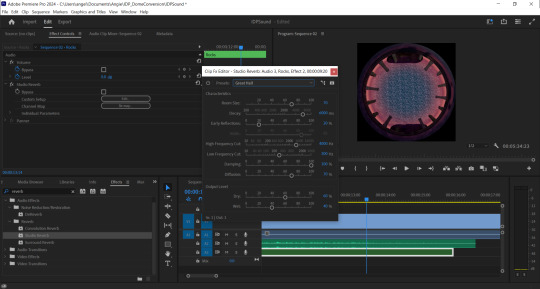
Fig. 1 A screenshot showing the application of Studio Reverb.
The echoes unfortunately did not extend beyond the audio clip length so although echoing through the clip, ended abruptly. If this was After Effects I would assume that a precomposition of the audio layer would allow the software to echo even where there is no actual audio clip. I found that the premiere version of precompose is called ‘nest’. Indeed this worked as I intended. Duplicating a small audio file, adding it beyond the end of the composition and nesting that too allowed the final audio clip to echo as well.
The sounds now matched the scene far better. The sound links below show the originals and how small they sound in comparison.
I added the sound of wind and calm water to connect the viewer to the scene more as well.
The sound of the clock increasing in speed was a challenge as the speed ramp effect only worked on video instead of audio but I found that I could increase the speed of the whole layer linearly so just duplicated the audio layers, speeding each one up with a fade between them all.
I applied similar effects to all of the above for the wormhole and final scenes, but layering the sounds for the wormhole effect was both fun and challenging (see fig.2).
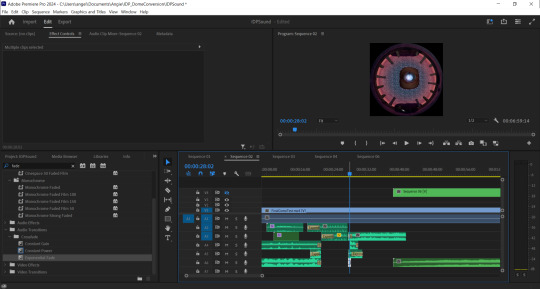
Fig. 2 A screenshot showing some of the final layers of sound for the wormhole effect.
The music we chose had an ethereal, mysterious and slightly unsettling feel and worked well as a more ambient track that did not draw too much attention to itself and did not overpower the direct environmental sounds such as the rocks or wormhole. I feel that the overarching music helps tie everything together and make it a more harmonious experience.
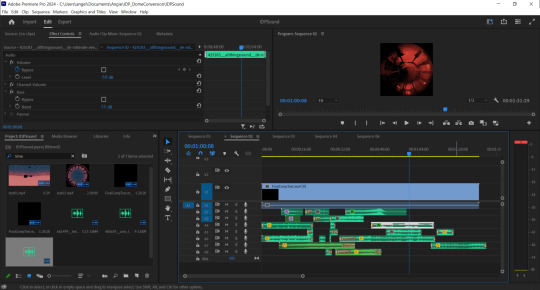
Fig. 3 Screenshot of final sound composition.
The Final Composite
youtube
References:
allthingssound (2018). de rottende veerboot. [Sound]. Freesound.org. [Online]. Available at: https://freesound.org/people/allthingssound/sounds/425183/ [Accessed 12 February 2024]
carmsie (2012). PB It is time.wav. [Sound]. Freesound.org. [Online]. Available at: https://freesound.org/people/carmsie/sounds/168303/ [Accessed 12 February 2024]
carmsie (2012). PB Remember Remember v2.wav. [Sound]. Freesound.org. [Online]. Available at: https://freesound.org/people/carmsie/sounds/168305/ [Accessed 12 February 2024]
DylanTheFish (2018). Warp Speed.wav. [Sound]. Freesound.org. [Online]. Available at: https://freesound.org/people/DylanTheFish/sounds/454683/ [Accessed 12 February 2024]
felix.blume (2023). River bank, waterfall distant loud, lapping water, close recording, bird, subtle cicada in indigenous village Salto Hacha in Amazon rainforest. [Sound]. Freesound.org. [Online]. Available at: https://freesound.org/people/felix.blume/sounds/674104/ [Accessed 12 February 2024]
f-r-a-g-i-l-e (2019). Buttery Breakbeat Synth, octave playthrough. [Sound]. Freesound.org. [Online]. Available at: https://freesound.org/people/f-r-a-g-i-l-e/sounds/500662/ [Accessed 12 February 2024]
het_HCKM_DS_... (2022). Mortality Boring Death Dying clock tick tock klok tik tak incl 20 Hertz sometimes. [Sound]. Freesound.org. [Online]. Available at: https://freesound.org/people/het_HCKM_DS_huis/sounds/661499/ [Accessed 12 February 2024]
Jovica (2008). Pad 006 - Whispering Ears - D4.flac. [Sound]. Freesound.org. [Online]. Available at: https://freesound.org/people/Jovica/sounds/52489/ [Accessed 12 February 2024]
kernschall (2018). SFX_Stone_Calcit_DeadSea_Avalacne_foot #3-178.wav. [Sound]. Freesound.org. [Online]. Available at: https://freesound.org/people/kernschall/sounds/425017/ [Accessed 12 February 2024]
klankbleed (2017). wind gap indoors 001 170305_1100.wav. [Sound]. Freesound.org. [Online]. Available at: https://freesound.org/people/klankbeeld/sounds/383139/ [Accessed 12 February 2024]
Robinhood76 (2021). 10105 big stone crush impact.wav. [Sound]. Freesound.org. [Online]. Available at: https://freesound.org/people/Robinhood76/sounds/567840/ [Accessed 12 February 2024]
X3nus (2020). Ardanbanapolis Interstellar Hub.flac. [Sound]. Freesound.org. [Online]. Available at: https://freesound.org/people/X3nus/sounds/513487/ [Accessed 12 February 2024]
Zimbot (2011). Portal_Continuous_Rumble.wav. [Sound]. Freesound.org. [Online]. Available at: https://freesound.org/people/zimbot/sounds/122972/ [Accessed 12 February 2024]
0 notes
Text
Character Design and Animations:
These images all represent my character design for my game. When I thought about how to design this character I had to think about the whole balancing ideology. This is why I designed a man who balances different objects whilst riding a unicycle. The main designs I had to focus on were the idle, Tilting left and right, Falling (L&R), Death (L&R) and peddling with both feet. I am very happy with how these designs turned out and I look forward to seeing them used in the final product of this game.
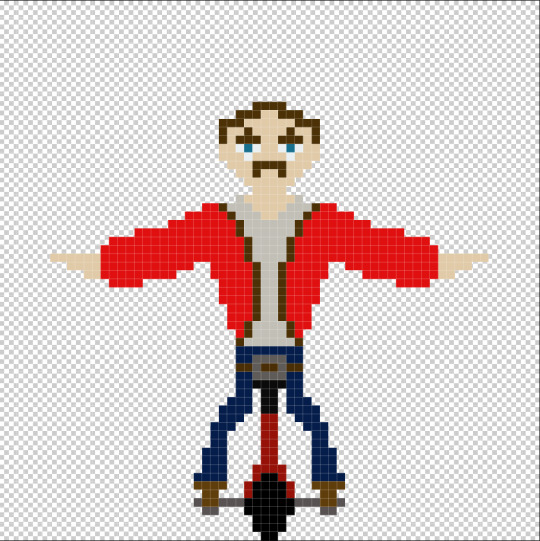
Idle: This design was the main foundations for the others. With this design, I had to be symmetrical with balance in mind. I also tried to design the arms so they would be outstretched and the hand were held out to hold the stacks of objects. With the facial design, I tried to make my character look old fashioned so people would look at him and know he is a veteran of this sport.
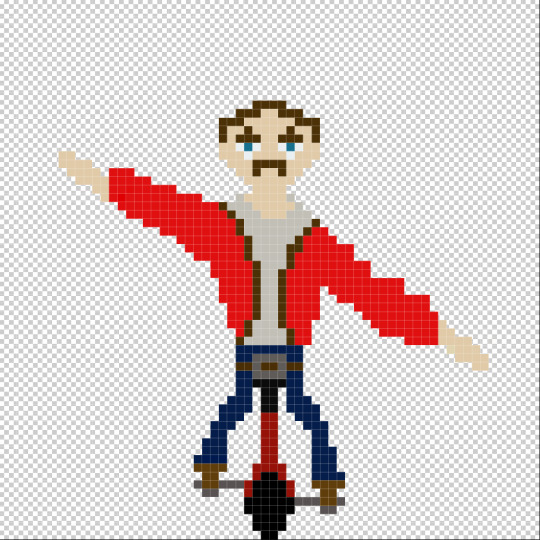
Tilt Right: This next design was fairly difficult despite me only having to change one thing which was the arms. To do this, I had to rotate the arms to a fairly balanceable angle using CTRL + T thinking about how my character would balance the objects in such a precarious position. I found an issue when doing this in which the arms went blurry as this happens when you rotate pixels on photoshop because they're square designs. This was easily fixable by readding the cubes in slightly different areas to make it look like the arms had moved
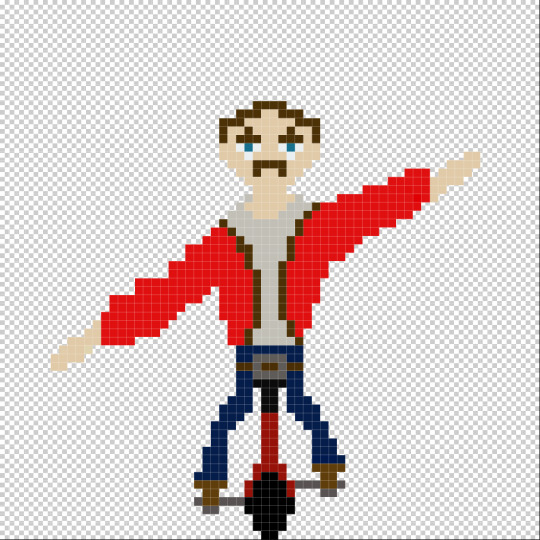
Tilt Left: This was probably the easiest design as all I had to do was flip the previous design horizontally creating a smooth and identical design.
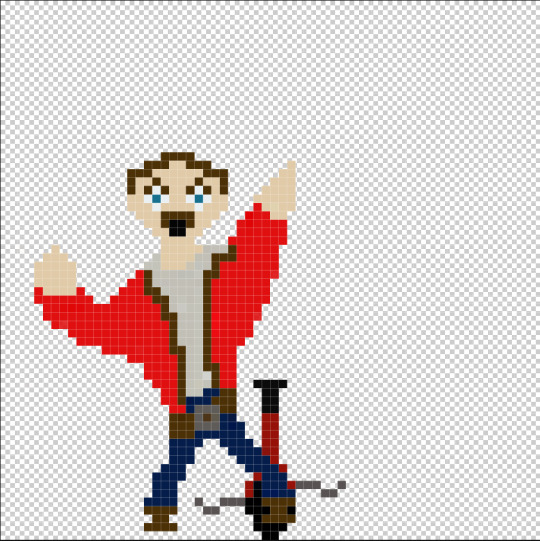
Falling (L&R): This animation was hard as I had to actually throw the character off the bike and completely change the arm positions. I first took off the arms and my character off the bike. I then tried rebuilding them shorter and more upward so that it looked like the character was falling. I also changed his facial expression as well. I wanted him to look shocked and scared. To do this, I added a black square to create a mouth open effect and then raised the eyebrows as well as expanded the pupils.
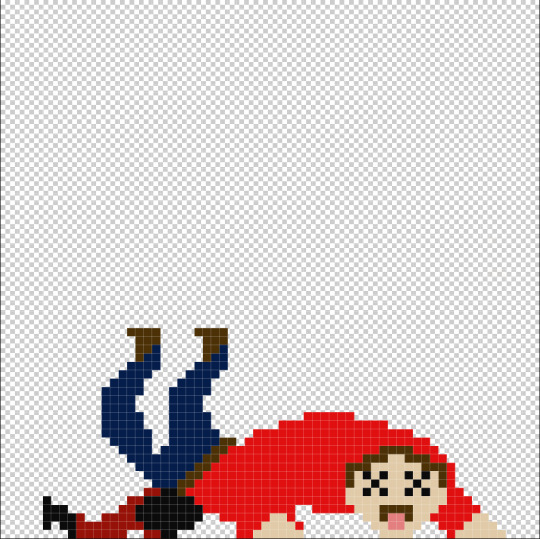
Death (L&R): The final design I did was the Death design. Based on the rules for this game, the character isn't actually dead but I will abbreviate it as this to make things easier. This was the most difficult design because I had to actually design my character so they were on the floor. To do this I used the same legs and changed the angle of them to represent the state of my character. I also used the same head and positioned it so it was on the floor and gave the character cross eyes as well as a tongue sticking out to make the character looked "dazed" and "Confused". The biggest challenge for me and this design was recreating the whole body and arms from scratch. I did this because I would have struggled to use the normal body design in this state. I designed this part so the back was arched over and the hands were flat on the ground so it looked like he had just made contact with the floor. I also morphed the bike on the floor so it looked damaged from the crushing impact.
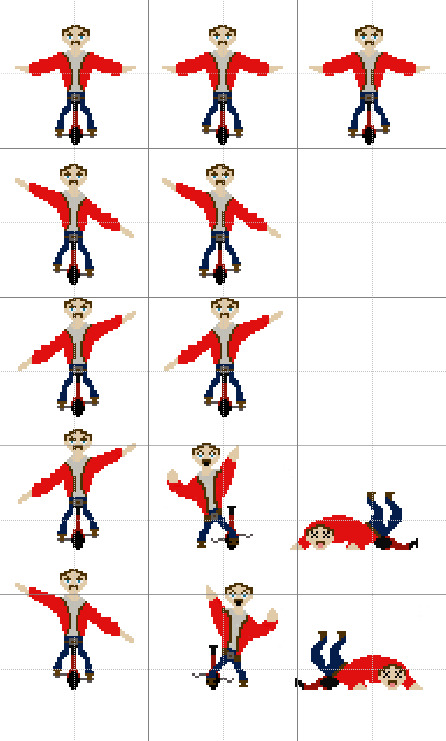
Sprite Sheet: This was the Sprite Sheet that I made in order to import each of these designs into UE5 to use them for my player character and their animations. I did change some of the animations but only once I'd imported them into Unreal.

Sprites Extracted: These were the sprites I extracted once I'd imported the sheet in UE5. To do this, I applied paper 2D settings to the sheet and then extracted the sprites by right clicking and going to sprite actions.
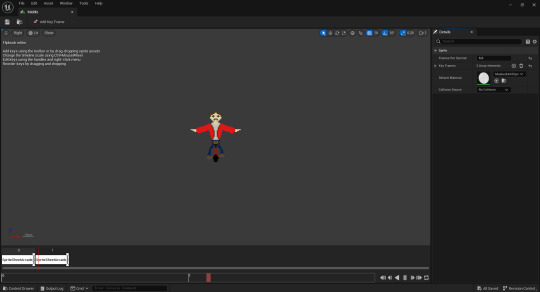
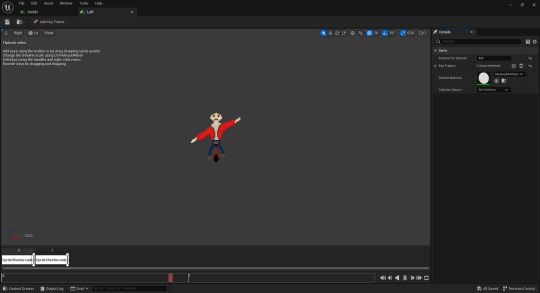
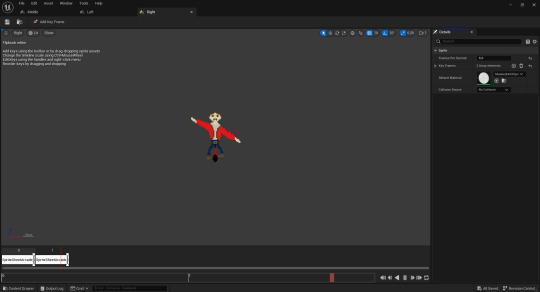
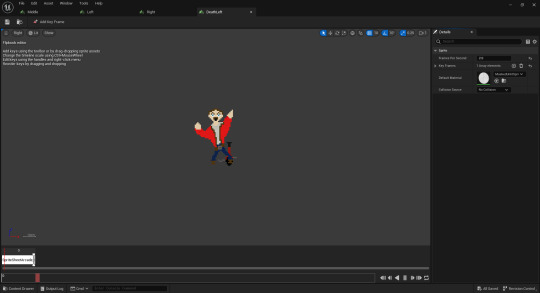

Animations:
Idle: The Idle animation was quite basic. I used two different sprites with each of the feet peddles either way round. I then changed the speed to 6.0 frames per second so the speed of the peddling was smooth.
Tilt L&R: For both of these animations I was able to keep the arms in their respective directions. However, I once again had to make it so the feet of my player character were still peddling. I will eventually plan to make the animations so that when I move in a direction, my player will move left or right and then when finished it will return to the idle animation.
Falling L&R: These next animations only consist of one frame for each side. I plan to play these when my player character is on the verge of falling of the unicycle once it reaches a certain point.
Death: This animation is quite unique as I am not using it either way. I plan to add ragdoll physics so when this still image plays it launches in a certain direction depending on what way the character falls.
Adding My Character to the Viewport: This is my player character added to the viewport of the blueprint. I had to increase the size of the character to 3.0 on each axis so it was a similar size to the default mannequin you get at the start. All the boxes around the player are the different collision boxes that will allow my player character to balance the objects.

0 notes
Text
Duck AI


For all of the projects that I have done, I have included some sort of reference from my last game (duck mario - Quackers) . For this game, I have made a duck which will randomly travel the area and run away from the player. You can also step on them and squish them, just like my original game but wont score you any points. The code for this is quite simple compared to my other code.

For starters, It receives the event begin play node which goes into a branch. The branch only outputs on false if the movement is stopped. If false, it then goes into a 'Is Valid' node to check if the player character is in the world. Then it either goes into a branch or repeats what It just did. If the player is greater than 750 distance away from the duck, it will start to roam, however if it is false, then it will start to run away from the player via this code:

This code just gets the location of the Duck and grabs a location around the duck at random and travels to that location.
If the branch is false (i.e. the player is closer than 750) then it will start to run away via this code. First, I needed to grab the direction the duck will be traveling away from the player from. Here is what I have:

This grabs the location of the player and the duck and finds the 'look at rotation' from the duck to the player. It then inverts the rotation by just adding 180 to the rotation:

Next this rotation is feed into a 'set world rotation node' but isnt set for the duck itself. Due to my limited knowledge of unreal, I did not know about the forward vector node and therefore I made my own forward vector. What I have done is I have made a collision-less invisible arm with a carrot on the end (a block) which is the point that is grabbed for the location of the 'AI move to' node. Just like this:

However the arm can move 360' instead of being fixed.
From this, made the duck jump a slight bit to make them a bit more visible.

As you can also see in the image, I am getting the location of a cube (the location the AI is moving to) and the location is being fed into a collapsed node I called 'Terrain Scan Area'. Inside of this collapsed node its adding and taking away 150 from the height axis (Z) and exporting it as 2 different vectors (1 being purely x,y,z, and the other being in a variable).

Next is uses those variables to get the terrain height. I found that the AI will not move to a location in the air and will just fail, So I made it that it will scan for the terrain height and teleport the block to that height so it is level with the floor. If the line trace returns with nothing, it repeats the steps again however if it does find a location then it goes into a collapsed node called 'Move Away From Player'.


Here you can see it grabbing the location of the floor as well as setting the location of the travel to point to the floor as well. Then it goes into a AI Move To Node. After this point it is quite simple with the AI's speed just changing.

Making the step on crush
I wanted to add another feature from my last game, so for that reason I decided to make the player able to squish the duck by stepping on it.

I first used a collision box and a cast node to see if the player stands on it. If it has, then it squishes the duck using the 'set world transform' node by setting the Z axis to 0.05 (half its existing amount). Due to it being a transform node, I had to give it other information e.g. the world location and the world rotation.

After that, I used a AI MoveTo node to refresh the movement and in return stop the duck from moving. I could of use a node called 'disable movement' however I used this method. I then set a variable to true to disable the roaming of the AI. After this point, the squish sound effect is played as well as the respawning and deletion of the duck:

Overall for this code, it was a bit confusing to make however I tried my best and created alternative ways of fixing the problems instead of the way that others would of done it.
0 notes
Text
The cat is alive! At least for today. 20 Mar 2023.
I wrote down the date. I knew I had: I kept saying to myself that I had told you the date in writing so that drove the conclusion. It did not occur to me, under the stress, that I could look for that. I wish I were kidding. It popped into my head, but the panic made me miss the obvious, meaning the panic is self-sustaining, has a boundary, has movement around that boundary which prevents proper action. That we can take apart later today. I’m really looking forward to that, because it finally occurred to me to search this blog. That didn’t help because Tumblr only ‘remembers’ the posts which are loaded by it. I typed in March and got only the last few days where I used the date. So I scrolled back to the beginning of the year. Couldn’t find it. Then I realized: I hand wrote it! That narrowed it down. I found the reference and it clearly says March 28.
So no betrayal! The cat lives!
At least for today!
The amount of pressure that applied to me was unreal. The guy I’m in was entirely calm, while I was freaking out. This isn’t just a case of dissociation of inner and outer self: it was entirely tinged, all the way through, with the identity issues, meaning largely gender and sexual identity.
That’s the idea I couldn’t get into words last night. The thoughts about issues in spaces like gender and trans and other non-binary identifications is that you don’t purely become a binary this or that as your ‘non-binary’ choice or as your swap or transition. I carry with me the patterns of thought and behavior from being right-handed. It makes me right-handed though I really am not, though I function better in every single way when I am left-handed. That this must be true is obvious in gs, especially given the D-structure, meaning that you are tinged, are labeled, no matter what labels you apply to yourself.
It’s amazing how the focus shifts when the panic starts to subside. Now I’m worried about you taking on so much.
I had written my farewell notes in my head. You saw some of them in print, and they got ‘better’, if you call it that.
I wasn’t able to get out the example I had in mind. Here’s another. When I see you, I see you. That was a strange realization which truly sank in yesterday, under all this pressure, when I realized I hold you to your standard, not to mine, that my criticisms of you in my head are a version, a 1-0Segment flip of the ones in you, which I can see when I look at anyone else. So, you should be feeling good when you look in the mirror because I now look in the mirror and I see the person you want to see in the mirror. I’ve gone over this feeling before, and that’s the first time I’ve been able to articulate the thought.
Back to bed. It’s still early and maybe I can sleep without my hands curling to my face in stress.
————-
Not much sleep but an interesting experience, which included an examination of panic as rotational speed, as an object, a gear which spins fast to avoid connection with others, meaning it is analytic to that pole, meaning a whirlpool like I painted on the wall of my bathroom.
That startled me. So I went with it and started to think that maybe the way I’m sitting now is actually part of the transition. I want to give you back your girlhood by combining mine with yours and for our boyhoods to merge in the same way.
That made me turn my head the other way, which made me realize I used to sit the other way, like how I’d lead into tasks with my left so my right had the higher degree of freedom, and thus control of not only the movement but of the structure and its supports. So I started to handwrite and realized that fundamental motive seems to appear in the ways you can use a notebook, as highlight by the strange way I do mine: right to left overall, but left to right within, so you open the cover like the book is in Hebrew, but you write and read first on the left, then the right, then go to the left beyond, meaning you count 3 spaces over, past the left you already wrote or read, over the right that you haven’t, to the next left. Then you count back to the right, then you count the same 3, then back 1.
Look at the inside cover: beginning on the left means the step back is to the cover, then count past that first to the next left. It’s the continuation of a pattern which reads both left to right and right to left, with one side dominant. This works the other way if we switch all the left and right labels, so this is the minimum for counting both methods: you get a choice of sides, and these count in the oddest 13 yet: the fundamental pattern of take 1 step back, 3 steps forward or 3 steps forward, 1 step back. The idea when we came up with that arrangement was to embody identification space so that a space is identified not only as one chain but as multiple chains or even combinations of sets, and that this skip over and going back is a lot like you have set the edge of your territory along that left side and now you have developed your territory within and you’re stepping out, past the edge, which makes a second identification. But what completes the identification is, and I’m loving this, is that skip over the right to the next left leads to the step back, which sets the identification for the space as now it is behind the front edge. Or beyond the line of scrimmage, because I thought of the line advancing, then the QB drops back and they throw a pass forward, so they line up there, then drop back and another pass forward.
So f1-3//3-1 has been recreated or rediscovered. Does it fit? I know it does, but I can’t accept that without doing the work. The fundamental expansion and contraction of a 1Square to a 4Square sets the boundary of the 1Square relative to the other 3 gs. I’m seeing it as a breathing motion, as the 1Square blossoms, then the contraction to the next gs along the szK, then the breath. Exactly like the old pictures I found which I posted over the weekend. So yes, this does exactly embody. Now I remember thinking that. Good.
And? So what? So I organized these notebooks with that thought. And that lets you identify these chains. And these chains rotate a Triangular: if you count around 1 2 3, back 1, then you rotate the End count around the triangle. So this combines SBE with Halving, because this also organizes by 2’s. It occurs as the count of 2 new when you skip over the right. It occurs as the count of the 2 skipped rights over a left. It occurs as the step back because that divides or Halves the space within the current edge.
I took a break without posting. I feel like I should apologize for stepping away, though I imagine it’s us taking a break and doing something else. Like I just did some fantastic left side learning and stretching, which included thoughts about how might say to a person, it’s not your religion that’s wrong, but your version needs to conform to the reality of the mathematics. So yoga and other systems of movement naturally express the same desires for connection and purification as any other culture expresses fitness, expresses ideals of movement and expression. Didn’t this used to be obvious? Is it obvious? The French were seen by the English as ‘weak’ because they like dance at Court because ideal dance expressed the ideal movements one had to follow, which could be portrayed as reflecting form over substance, even to death by over-heroic acts. It’s interesting this conception persisted when Napoleon was beating everybody. And I’d say the issue Napoleon faced was that you can’t innovate that much with 1800’s military: no planes, limited artillery, no repeating weapons, only horses or foot transport. So the space he had to operate in was finite. If I can translate that, it would be gold.
The space he had to operate in was finite because the Dimensional Enclosure generated to a 0 boundary which inverted to the limits of his capability to fit to the DE, which I’d say he largely accomplished. In that light, I can even see the attraction of Russia: not to conquer but to take over from the Czar, meaning to become ruler of an existing Empire which he would run better, which would make his Empire the best ever, etc. Install a new Czar and that entirety inverts to and from him 0-1-0.
But finite also means that when you count a certain number of times, you reach that 0, which translates along the line where that occurs through to Waterloo, as all the dimensions line up to that Actuality.
I can’t quite see it in grid squares. Yet. So, let’s use the counting above. He’s ahead, and the others catch up. Because the utility of the ways he’s ahead, like in his conception of political organization, do not have the same effect within the Space or are, perhaps better said, more removed from the Actuality of the conflicts, of the battles and related events. So, they could catch up because the space imposed a finish line for military advantage. Phrase that in I//I and that becomes rational, which has a denominator, so the idea is that finite order is that denominator, whatever that is, so finite and infinite, which is exactly what I//I enables. OK.
So D3-4//4-3 acts as I//I in any moment at scales. That’s really cool.
The moment as a Counter again with the Observer.
There’s something I’m having trouble getting about the subgroup being finite, meaning an element is finite as a finite subgroup, which means in I//I that it must reach a 1 that can become a 0 or there is no 0. Oh, the flip appears: the 1-0Segment!
——————
I’m getting upset, and not out of panic but anger. How could you do this to my family? I spent the weekend experiencing the nightmare of having to tell my children: I’m dead and I destroyed all your lives. And now I have to turn to Debbie and say it’s less than 4 weeks until your beloved daughter gets married and we have to file for bankruptcy. Why? Because the promises made to me are always being shuffled off into the future. She’s barely hanging on now. The stress is physically hurting her. And you do this to her. How can you do this to my family? How can you hurt them like this?
It’s unnecessary. It’s cruel. So now I’m picking up on negatives and then I start to think that isn’t what you are, and I know that but I can’t understand this behavior. It’s wrong. Just plain wrong.
I can do the forms. I’ve been reading through them. Can’t find the lawsuit, but I can get the details. I cannot fathom why this is happening. What good does it serve? Why hurt people when the idea is to help them? When the idea is to stop pain, to stop people hurting, to stop people from hurting other people, and from hurting themselves, then why hurt Debbie, who is a complete innocent? Why hurt Rachel, who is a complete innocent about to get married? Why hurt Jordan? They do not deserve such callousness.
I get the reference: why are you still writing pages? Because that’s the process, but this is a finite group in this finite existence. I am a finite group in this existence. My processes all have biological Ends, really the analytic Ends where the processes of life here 0. And while that enables 1 in eternity, that means it’s 0 here and that means you’re affecting others and their eternities.
What kind of example is it to say: we wouldn’t even help the one of us who did the math? We inflicted gratuitous cruelty on his family. So come on and join the party because it’s much better to be aware. Great message in that lesson.
It stands against everything I think about. I get up to take care of the animal’s needs because he asks me and I’m not going to assert the right to not listen unless I have a good enough reason, like it’s too late or too early or he needs affection while I’m doing something else. If I don’t have the energy, the motive force, to care about his needs, then shame on me.
Maybe I can talk more about the panic loop. It’s a neat example of an elliptic: there’s a rational point, which this weekend was the date, and that extrapolated into an entire scenario which is the developed as the curve constructs, which is mechanical, all connecting to that original rational point, which is thus the mapping of Irreducible layer to layer in I//I because you have the rational points, indeed the curve on the one Irreducible or as constructed by the layers both with the complexity in the rest of that gs process mechanism.
You can see this happen over the weekend. I fixed that rational point, which was that my memory was wrong, held that versus it was correct, and the loop developed. This loop turned so fast I could not see that I had the ability to look up the truth. I filled that space at very high speed and grew very tense. I thought my chest was going to explode.
I see a theory developing, which is that the outer person, my shell guy, operates under I//I principles at a slower internal rate so he can act faster on an external basis. That explains why I keep trying to get myself, my attention, out of the way: focus on physical activity requires focus on the physical activity. In part perhaps because I’m cross-wired left to right and back, so another example of this Winding pattern. This spins and that projects a 0 boundary over the 1Space (and thus a 1Space boundary over the 0Space). Kind of like throwing a discus if the discus itself spun larger rather than in a line or arc, so it would expand and then contract over the space of that line or arc extend over the field. Like if you stood at the center and hurled disks repeatedly with a blindfold so the direction shifts.
That enables a lot of comparison.
So, that would explain why I spend so much of my time trying to slow my mind down. Playing music as I should means reducing the external gs processing to the act of playing so that externality bounces around 0, meaning it 0’s in such a way that the music keeps moving while also counting resolutions and other forms of Endings. All those hit 0’s because they’re all analytic in gs process.
Oh, I get it. I’m the one who put us into this mess in the sense that I’m the one who forced the error that cut my tendons. It wasn’t him. It was her. Or me. Because my speed put way too much dimension into that moment. I remember how I was caught up in the silly storyline of teaching my brother how he could in the future get his own bottle down though he was just then crawling.
That’s exactly why I want you, need you to make decisions for me. Oh, so if it works that way for me, then it works the same for you. There is an experience way back when this work was really getting going, when I felt that I accessed a mind, yours, which was spinning super fast. And I passed that off because it reminded me of the Twizzies, of the twins who spin, and one holds still and that’s I//I because we dance with our hands tied because that forms our space for spinning. I’ve seen that image countless times and now it makes sense.
Slowing my mind down as search translates into slowing I//I so the spins match for what I’m doing. In other words, rather than slow down, I Wind faster, tighter, around that loop, around the hole that loop describes, so it’s boundary to center as 0-1-0, and that shrinks the 1Space down, so in the 0Space, I can’t see the choices clearly and start spinning pat them becuse I must have missed something except I keep missing it because it’s only visible when I slow down sufficiently to focus.
So internal processing speeds can go haywire compared to external processing speeds. Athletes and the uncoordinated. Depth of athletic skill too: fast processing with less depth from the internal side of the I//I.
How would we treat that? I keep reminding myself with little success how things have gone. Does not work well. Medication works but it isn’t full time and the gaps in coverage can be enormously powerful. That’s something people seem to have a hard time grasping, that medication of any kind has gaps and those are dimensional spaces, so when one appears constructs appear to fill the gap. Oh, and the thing is that negatives have a bit of advantage: they can spin very fast because they need to come around to the positives, meaning they’re freer, they have more room, they can go fast on the open road, because they don’t have to tie to the Actuality as closely. Thus chance estimations or priors become very distorted because threads have to slow down to communicate to the external self, who isn’t slow but isn’t set up for that kind of DC&R because the external self has to deal with the external self’s finite groups. Like school or a show or a tour or a career is a finite group. Like a life.
So, as we’ve said many times, the D-structure reduces in grid squares to D3-4 threads meeting D4-3 threads. The external self is thus responding to the finite expressions, the finite order of the group of a you or me or whom or whatever. I can’t dunk a basketball unless the net is very low. So all the stuff I can’t do with the basketball has to get discarded, when of course most people can’t do that. They can’t become a performer like you.
Need a break. But isn’t that a cool idea: that we are groups of finite order within groups of infinite order. That is I am finite here because all the 0Space processes End, which makes a 0 of me here and a 1 of me in what is to us Eternity.
That is the description of the soul I’ve been looking for. Tangible you is a finite group in gs process. Golden thread indeed within an orthogonal space.
Your stagecraft is exactly you. Exactly you. Tangible and intangible.
—————
Some thoughts came that I would normally try to exclude, but I think now I have a way to address and maybe analyze those. So as uncomfortable as this makes me, I was thinking about how R and I can tell D to stop worrying about the wedding, to stop trying to take on jobs that don’t exist, to stop trying to do work they don’t want her to do, that they are getting married because it’s a legal step and they don’t see this as a big deal in a public sense at all. They want it casual. They want it relaxed. Then I thought, like you or I would. Then I thought like you would if you got married. Which became you’re married. Which became this is all a hoax, which led me to say, wait a minute I’ve done this before: why are you tipping to negative. Which mean the negative automorphism, a flip of the 1-0Segment at that End, so we can infer a result based on these dimensions reflecting into that negative image of you. Then I thought of the song and how that has the opposite meaning of that, particularly in reference to the sadness because this is a choice of sadness for the sake of Eternity. Which deserves capitalization there. So, if everything lines up to say you’re the embodiment of that positive, I take the gap and infer a negative which speeds very fast to exclude comparison, which is a form of insistence, which connects - finally? - to the long ago idea that the flashing light in my head regarding my damaged hand was actually trying to get my attention, not turn it away, but I’m incapable of seeing that because my internal identity connects to my shell or external identity.
What a strange result? Why would we loop destructively? Why do birds pull out their feathers? Stress. Pressure caused by not knowing what to do and being uncomfortable, which pretty much depicts how I existed for most of my life because I was physically disconnected by the side switch. But why the message? Oh, because it’s food or flight: what draws attention at the base levels is food or run for it. And those can combine because danger lurks near your food. This connects to the dreams about a force in my life guiding me physically: it expresses you that way, what you want for me, not the insecurities. As in, all that fussing with my hair was to get me to accept myself, not to criticize my looks. That took approaching the left side to get at all. I mean as a right-hander, I couldn’t see myself in the mirror at all. I couldn’t see how I walked or stood.
So panic points are meant to say look at this and dismiss, like when the warning buzzer went off as Neil Armstrong was flying the LEM to the moon’s surface.
0 notes
Note
okay margot i may have not seen a httyd property since i was in elementary school but. what is your favorite dragon and why. my favorite was whispering deaths i cannot remember why. i think i thought the name looked cool and that big ball with tail and lots of teeth was an ingenious dragon design the likes of which i had never seen before. also it was long and twirly yknow what i mean? moved like a ribbon
cleb i would like to preface this by saying this is the best ask you could have ever ever sent me
okok i think my most favourite dragons ever and of all time are the stormcutters like sorry i cannot imagine anything sicker than this:

girls who are LITERALLY owls!!! also i think their fire is really really good it's a cyclone shape and it's really great 👍 also just how big they are & the structure of their feet fascinates me always and forever it's so good anyway this technically answers your question but i'm going to keep going this post ended up super long though so it's under the cut 😁
rumblehorns are really good imo can u believe they made a beetle a dragon. anyway it's really fascinating to think about how it can fly because their wings are pretty small for their size? as in thin length-wise. also the fact that they are tracker dragons makes me so crazy yesyeyseyses

also huge fan of deadly nadders which is a normie answer but hello have u seen them..
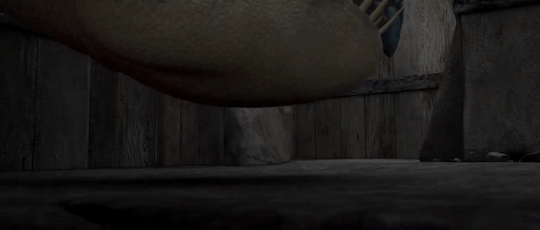
hi baby.. the movements on these guys are so good like u can really see the parrot influence obviously one of the best parts is in httyd2 when stormfly starts nesting on eret fdjhdf also the fire!! the fact that it comes out in such a constant stream!! and ALSO just thinking about the logistics of how the tail works is so fascinating because i think they were going for a porcupine thing but porcupines cannot actually shoot their quills while nadders can so how do they do that and how do they regenerate so fast! my theory is they're made of some genre of keratin but that's not really fast-growing idk it's an enigma!
another really great one is scauldrons look at them literally
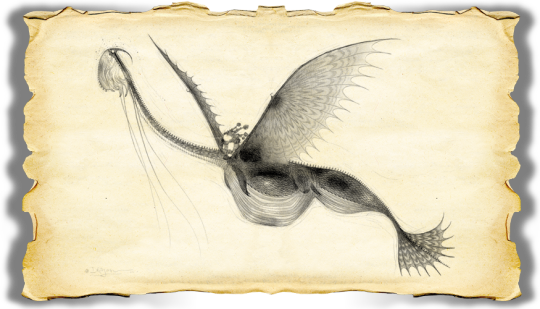
they're really funny to me because (a) they are SO thin it's unreal like where does all the flesh go when it's not being used to shoot water and (b) ok so we know water is really heavy right but we also know scauldrons can fly i'm not sure for how long but they definitely can do it um from what we have seen they're not the best at speed or maneuvering (obviously) but they compensate for that with their necks anyway what i mean to say if they are so heavy especially when they have the water in them HOW DO THEY FLY LIKE THAT!! THEIR WINGS ARE SO TEENY TINY HOW IS THAT SUSTAINABLE!!! also there is also the question of how they heat up the water that much but whatever!
ok now here is my good friend the timberjack hehe

i am so fascinated by them did you know their wings are so sharp they can cut trees with them. i love how thin their actual bodies are compared to their wings too.. also i think i'm not sure but i'm pretty sure timberjacks are somewhat related to typhoomerangs because they're built really similarly what with the thin body and the massive wing ratio
and ok yes i WILL talk about whispering deaths because they RULE! HELLO BEAUTIFUL!

the rotating teeth are really good like it makes sense ofc why they would be burrowing dragons (FASCINATED by how fast they can burrow btw) again the wing to body ratio fascinates me but it's whatever because they shoot RINGS OF FIRE!?
on a sidenote: screaming death.. what a sicko i'm obsessed with u
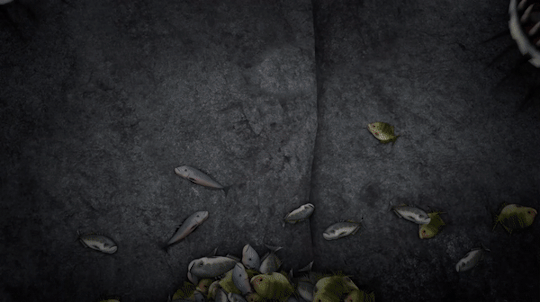
also OBLIGATORY skrill discussion i'm not as obsessed with it as some of the others on this list but wahoo girls that will shoot lightning.. their concept art is all reallyreally good look
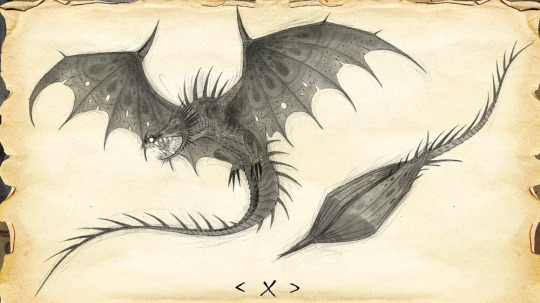
hai..
also ugh fine ok i will talk about night furies 🙄 they are my other first most favourite but like that's normie talk because they're everyone's favourites :-) like look this is really really great

really sooo great toothless i love u i would die for you we do NOT talk about the third movie EVER they cocked it up SO badly literally will die for my 'the light fury should have been a aquatic animal' agenda but it's whatever and their stupid little babies suck and i would drop-kick them if asked to. i could fix the light fury .. no one gets it.. do you guys want to see the concept art (it's MY post I get to choose what images you people look at)

like this is so great . we could have had it all. it's still not perfect but it's better than whatever nonsense the third movie gave us one day i'll write a post about how much her design sucks and then you'll all see!!
13 notes
·
View notes
Text
Week 8 - Digital Iteration
This week's tutorial was really interesting and entertaining. One of my personal hobbies is digital rendering (mainly in Blender), but it was really nice to go out of my comfort zone to a program I have only ever used once before. When I opened 3ds Max for the first time, I noticed how similar the interface looked to Maya. Being Autodesk programs natively, it made sense, but it was nice to have some element of familiarity.
During my year 10 and 11 high school holidays I completed a Cert IV in digital design for games and film. That coursed used Maya and Unreal Engine 4, so I had a bit of experience with the interface and principles of polygon modelling. However, 3ds max was probably one of the popular programs which I had the least experience with; so it was still a hugely informative and insightful process trying to adapt my knowledge between programs.
I started with the primitives menu, and imported a sphere into the workspace. I initially found myself struggling with the interface. There are a lot of options and features which are not necessary when learning the basics of a program. When starting to learn any 3d program, I often find myself spoiled for choice, and perhaps even too overwhelmed. I was very glad when the tutorial suggested hiding some superfluous menus from view, as I felt that it really cleared up the screen. After aligning the views (Image 1), I experimented with the modifiers tab.
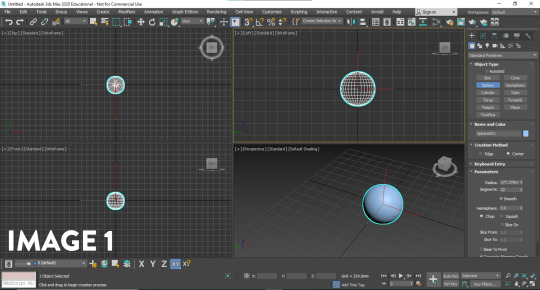
The modifiers in 3ds max were really interesting to play around with. Working with meshes can sometimes be a tedious and particular process, but it was really enjoyable creating something with no end goal in mind. I liked how using a squeeze modifier (Image 2) could generate an egg shape with the sphere primitive, and how the melt, twist and wave modifiers (Images 3, 4 and 5) could be pushed to the mesh extremes. When working with a mesh, the topology is important to the quality of the final form. As the entire object is constructed of tris and quads, the way they are situated on the model, and their resolution play an important role in what you see. For example, the more I increased the twist modifier, the more I could see the vertices sticking out of the shape. It goes to show that unless the resolution is increased, there are limitations to the modifiers usage, as they can 'break' your model.


The modifiers in 3ds Max are very different to the ones in blender, I definitely feel like in any 3D program, anything you can create in one is attainable in the other; however 3ds max has a lot of mesh deformation modifiers out of the box. Although I thought these created really interesting and abstract shapes which I certainly enjoyed, I realised that I couldn't think of many instances where I would use some of the modifiers on a real project, but I think they are really valuable for niche tasks.
My favourite part about the exercise was learning poly modelling in 3ds Max. Poly modelling is a core part of most 3d modelling programs; and the skills are usually transferrable between. There are some really fantastic modelling tools in 3ds max which make the process of modelling enjoyable. I had a look around my desk for some quick and interesting forms I could make, and started with a really simple apple using the sphere I had in the viewport. I utilised the 'soft select' (Image 6) feature to move many verts at once, to create the top and bottom crease in the apple where the stem travels. To create the stem, I used the cylinder primitive and used the taper/bend modifier to create a curved and natural form (Image 7).
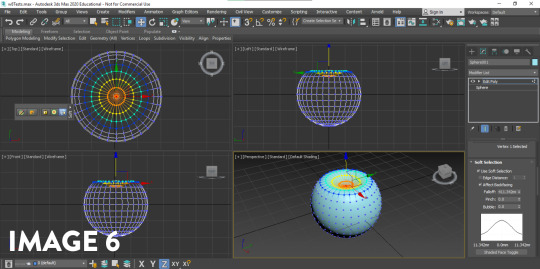

Next, I used the cylinder primitive and used the scale and extrusion feature to get the barrel of a pen. To create the tip of the pen I target welded the vertices together to get the point. I created a new cube primitive to create the clip on the pen, and extruded it (Image 8); also creating a bevelled edge to round it out slightly. Using the same techniques, I also made a stool from my room (Image 9). I really wanted to experiment with as many features as I could in these exercises, so with each 'sketch' I tried to focus on a tool I hadn't used before - as it felt like the best way to improve (Image 10). Still getting comfortable with the Poly Modelling in 3ds max, I also made a cupcake (Image 11) from the basic cylinder primitive to try and improve my modelling quality and speed; making simple extrusions, scaling the rings in, rotating them to get the icing layers. I played around with NURMS subdivision on the mesh to smooth it out, and was really happy with the results.

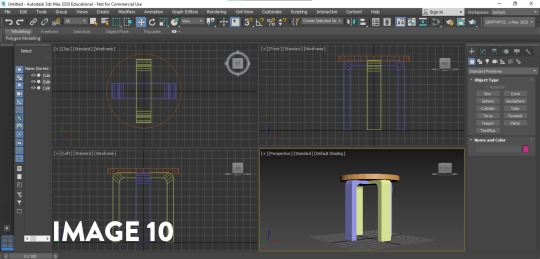
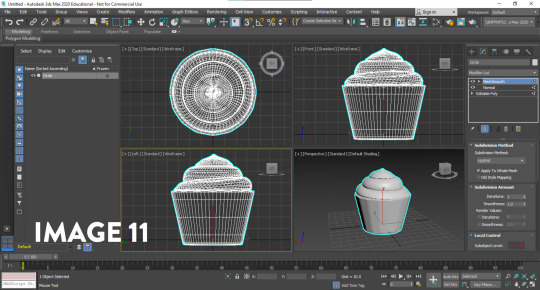
Finally, I wanted to use all the skills in conjunction, as well as using a tool which really sped up the workflow. I knew from Blender and Maya that loop cuts sped up the process, but I could not find them in 3ds max. After researching the issue on different forums, I found that it went under a different name; Swift loop Though it was very basic problem solving, it goes to show that these skills and programs have transferrable knowledge; and doing a simple search of your problem can lead to new ways of solving them. Swift loop was really useful in creating a loop cut between two parallel edges; adding more geometry for manipulation. When creating the tape dispenser, I noticed that the subdivision was rounding the model out too much, to the point where it no longer registered as a tape dispenser. So I used the swift loop feature to create loop cuts close to the bordering edges to reduce the interpolation between the curve (Images 12 and 13). This taught me that the subdivision modifiers aren't just something that can be added to a model to instantly make it look better; they require some manipulation and editing to get the desired effect.
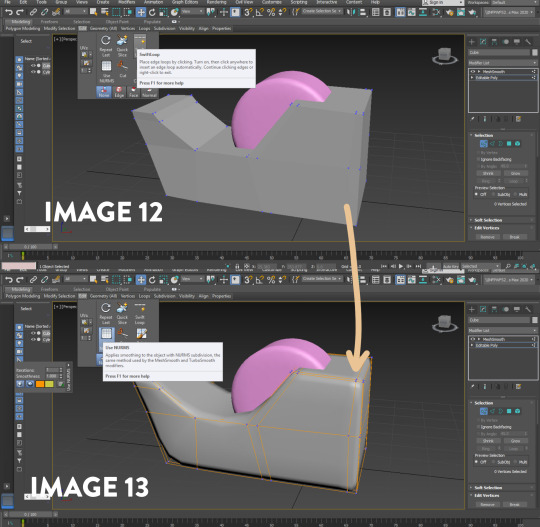
I found 3ds max challenging but really interesting and insightful. As I am familiar with other programs of similar nature, it took me a while to get out of my own head; using shortcuts and hotkeys from the other programs and wondering why it wouldn't work. Overall, I think that its really rewarding to pick up another program, as it expands my skills and approach to modelling. If I were to redo this activity, I think I would try and make some more complex forms now that I have gotten more comfortable with 3ds Max; perhaps moving onto a product or more complex object. I am really looking forward to creating the bottle concepts in 3ds max next week, as I believe it will be another chance to improve my skills.
Thoughts on the Pre-Class activity - Andrew Simpson case Study
I believe that digital modelling and physical models have a closer relationship than people think. Form and Materials are an important part of perception, but there are qualities of both physical and digital modelling provide when compared to one another. Digital models allow for material iteration, simulation and rendering. Physical models allow for the physical contact, and interaction with the end user. When Andrew discusses the importance of materiality, it drives home the necessity of experimentation and versatility in design. The idea of new materials informed new processes in his decision making process, and it lead to different material types being explored.
I found Andrew's discussion on model fidelity really insightful. I perceive high and low fidelity models to represent how close the model is to a refined product. Whilst a high fidelity model would be fantastic to show clients or to use in renders, low fidelity models are required to quickly iterate on concepts and ideas to test the boundaries of the product e.g. material, form, colour. High fidelity models are more refined, and have more time put into them, to explore how the end product will feel for the user. High fidelity and low fidelity models are both important, and when Andrew talks about the non-uniform relationship of the two in his process, it shows that design is not a linear process; rather a circular one driven by prototyping and feedback. If a high fidelity model still doesn't feel right, faster, low fidelity models can be made testing a range of new ideas; to be taken through the process of design once again.
9 notes
·
View notes
Text
Well that...exists? No seriously, are we being pranked? Because I feel like this is a prank.
So, it’s an Awakening banner. But the shittiest possible Awakening banner? Like seriously, this is such a weird fucking mix, and for like no reason.
First up is Anna. Okay, fine. People really liked Awakening Anna, and frankly I adore the weapon name. Apotheosis Spear is fucking awesome sounding. She is gonna be fast as all goddamn hell, too. Seriously, that weapon scares me. Warp effect, she’s going to have at least 173BST by default and may have trainee bonus, and all this goddamn speed stacking. Also Joint Drive Speed exists. I was literally just talking about how much I didn’t want this. And here we are. Oh well, I guess. Time to consider giving that to my base Julia.
Then we have the unit I like the best: Say’ri. She’s finally in the game. Faster cooldown timer is nice, and conditional DC is...it’s there. Arguably Osian made it work, but personally I can’t help but think it’s shit. Also that archer fucking bodied her and her stance skill is around attack and speed so that’s really not a valuable effect at all. Kestrel Stance 3 is...nice? I dunno, enemy phase doesn’t seem as concerned about boosting attack and speed. Close Call is great, but I can’t help but feel like her toolkit isn’t that spectacular. Not even her special is all that useful. And she only deals 17 extra damage off of Iceberg, so that’s only like 34 Res. Not bad for a sword unit, but not exactly impressive either. Anyway I’m giving her a Shannan manual like immediately if I pull her, so there’s that.
Then we have...the entire reason I don’t like this banner. Can someone answer me honestly: why is Mustafa here? He’s a nobody. He showed up in exactly one chapter and had a few sad dialogue moments, and that’s somehow enough to displace Miriel, Vaike, Kellam, Laurent, Basilio, AND Flavia? Like are we real right now? I actually hate that he’s here. And he’s the demote, which is somehow more infuriating to me because it makes him the easiest to merge and the most likely to encounter. I just hate everything about this guy. He’s got Defense Tactic, which is super nice long-term, but it comes at the cost of knowing it’s 5* locked and that his only other offering is fucking Water Boost. A skill somehow more useless than Brash Assault. Unreal.
Also hey, remember when the Thracia banner introduced Peony because they were just that unconfident about Thracia units selling well? Well fuck you, here’s a new Anima mythic in Mirabilis. On an Awakening banner. Guys, I’m so sorry. I honestly considered Awakening one of the favored children, but oh my god did their fans just get fucked over. Fucking Mustafa over literally anyone of value, and not even a fourth banner member, but a random-ass mythic added in for funsies. I’m just...in absolute awe of how shitty this was of them.
Oh, but it gets worse. Mirabilis is a red unit. And a Mythic. Meaning she’s going to be set on this month’s banner as a red unit. Meaning we’re back to this month’s legendary being potentially ANYTHING. Seliph is no longer a guarantee. So that’s great, super happy that the entire set of expectations for this legendary banner got blasted. Not only was Awakening fucked over, but now our boy Seliph is likely to get fucked over too. 10/10, Heroes, way to fuck this up hard.
Anyway she seems pretty good. If a foe has any kind of penalty, she penalizes them harder in combat for anyone in three columns. Which is a good effect range. Her dance grants +5 attack to all allies in two spaces, so it’s a slightly less potent Rally Attack Up+, but it also inflicts -5 Attack on the nearest foe within 4 spaces AND all foes within two spaces of that target. So everyone? Basically everyone. And this is a defense mythic dancer. Thanks for that. Oh, and her toolkit? Fortress Def/Res. Meaning she’s going to be bulky and hard as shit to take down thanks to all the attack penalties she inflicts. This is going to be an absolute nightmare, because even Brunnya doesn’t save you. Thrasir is on Anima season. Which means Brunnya gets bodied. Idunn does too because dragon. So effectively, there is no guaranteed counter to Mirabilis and Thrasir combos. This will be the new Anima defense meta.
And...wait. Wait a minute. “Mirabilis may or may not appear again in a summoning event held in the future.” That’s...that’s the Duo Ephraim lingo. Is she seriously not going to be set as a permanently recurring unit in the legendary and mythic banners, and also not be in the general summoning pool? Am I seriously to believe that we’ve learned nothing, or perhaps learned the wrong lesson that players will always go for this super rare thing as what they want to make comebacks from how hard everyone’s salivating over Duo Ephraim being made available again? Jesus Christ, this is dire.
Anyway, the GHB is Gangrel. Yay? Whatever.
Honestly this banner pisses me off. I think it pisses me off more because Mirabilis would be nice to put on my defense team, and that Joint Drive Speed skill would be so nice on my base Julia to keep her running at maximum capacity. I also like Say’ri best on this banner, but can’t necessarily justify pulling for her. I hate that this banner introduced a unit I can’t justify seeking out, a unit I don’t care about with a super good and necessary skill, a new really strong mythic hero, AND a demote that’s just...the worst, most bizarre choice possible. All while effectively wasting their Awakening banner for the rotation. Just...why?
8 notes
·
View notes
Text
Completing the Root Animation study
On Friday, I completed the full basic moves for the Root Animation moveset. The character now has walk run and an independent sprint function, with a jump that adapts to what action the character is taking.
vimeo

Blueprint for rotation speed

Blueprint that dictates the characters sprint
What the experience has taught me
Through this study I have learned some of the advanced tools unreal 4 has at it’s disposal, and how far the software has come since the days of unreal 3.
I now am aware of what goes in to the vast pipeline that is creating realistically blended motion.
With the knowledge I have now, It will also help me before exporting the animation to Unreal. With the options unreal has to lock in root motion, I can import animation without first zeroing it out first, Which means I can create my animations in Maya, and have them look exactly as intended in realtime, without any compromises that may occur from taking the root motion out in the 3D package before hand.
The next step will be to create extra features, such as climbing/ dodging etc. I may look to try and implement mechanics found in the games that are currently pushing animation in new ways.
0 notes
Text
The evaluation
Evaluation
In this evaluation I will be speaking about the process that I took to build the prototype game. I will be speaking about the way I felt the process worked alongside with what I did and why. In my blog, Blog for the collision. I go into detail about the steps recording my progress throughout the time i started to hand over. The game idea was to be a clone of space invaders but with a twist of being in first person mode. thinking about my steps being on a blog so I made sure that what I was describing also had visual representation as much as possible. This led to me writing in a tutorial style blog in the beginning being able to explain what i had done during my time. This meant that someone could open unreal and follow my blog along while understanding what I had done.
The Starting Process
I started to think about how I wanted to proceed with the project. Knowing that I would be the one to build the foundations for this project was a daunting task. I looked at what everyone else was going to do and although in the beginning i was going to be just doing the enemies I had to have something to fight them. I felt that I may have taken someone else's job over by doing this as the team began to break down in communication. I also found that the team was not in at the same time or at all. This was built up a small amount of frustration and then acceptance about what felt like an age of silence .
The Template
I started by knowing I would not be able to build the code from scratch. I felt that I would save more time and be able to remove elements of another code instead starting with a blank document. I started with the twin stick shooter template which gave me flexibility when it came to the visuals of the models to hand. This gave me the UFO model and the code to go with it. This also meant that I could go home and rebuild the game from scratch using the template to save time giving me two different versions, allowing me to practice what I had learnt that day or week.
I feel that using this for the beginning was beneficial to my work allowing me to understand and deconstruct the template allowing me to use my knowledge to test what I already know and build on what I need to learn.
Changing the code
The code needed to be changed, the process was simple I had to remove pins from nodes allowing for different gameplay. From the code I changed two different functions by removing the pins from the nodes. This gave me flexibility to be able to re-code them in if I had removed the wrong one.I wouldn’t run into any problems until I started working on the enemies code. I removed the fireright from the make vector along with the moveforward node from the code and this worked perfectly.
This was a great part of the process for me as I planned for the side to side movement and the one way shooting. Doing so helped motivate me with the project in the best way possible giving me a reason to think about the next steps which was how we wanted the player to see.
Changing the Camera and the HUD.
The twin stick shooter was a top down game, whereas the team and I wanted to change the top down view to be a first person shooter. I needed to go into the model of the UFO. I had to move the camera attached to the model into the position I needed to make the view change. I liked the idea of looking through the eyes of the little guy in the spaceship so what I did was move the camera down to the UFO object and rotate so the player could see what they were shooting. The down side was when the player moved part of the UFO got in the way. Although this was a problem I thought this looked really good if the other side matched (the back wing got in the way). I duplicated the model rotating and reversing the second model to have the wings display on both sides leaving a gap in the middle as a rudiment sight for the player. I felt this worked well as a baseline for the others to see the game take shape while I was building the prototype.
Enemies
Building enemies from scratch was a tough part of the project due to not having experience in this part of the project. Having to build the AI and give it a form of damage for the player and itself.
I thought about the theory behind it although my knowledge is limited within this subject I couldn't come up with anything.
I found a youtube tutorial the beginning of the video helped but had problems with it which led to me taking home a version and experimenting on the code itself.
During a lesson the tutor was showing us one of his projects and had enemies that died.
I started with a test build using a character over the actor or pawn.
I found out that I needed an on hit event with the enemy boxes and casting to the players projectile and I need to use the NAV-mesh for cube enemies, giving the cubes an area to move in. The code itself was simple and it was an event hit with a cast to the projectile. I ran into problems with the cubes ``killing” each other by running into each other. I had to change the code on them to be able to stop this issue.
Then it was a matter of small changes like the fire rate and the speed of the enemies movement.
Conclusion
I have spoken about the starting process, the template, changing the code and camera and the enemies.
Although this was a very frustrating process, I am very pleased with the results that I produced during this time. I feel more confident about moving and prototyping in the future. I hope my team liked what I had to offer in the end. Making blogs again have given me a motivation that I thought I had lost. Now that I'm back on Tumblr I am having fun again.
0 notes
Text
Pro Racer Test Drive: McLaren Senna
ALCABIDECHE, Portugal — The late three-time world champion Ayrton Senna claimed the first of his 41 F1 wins at the Estoril racetrack in Portugal on April 21, 1985. I thought about that win as I wandered slowly down Estoril’s long front straight. I had driven past the circuit about nine months earlier, on my way to do a 24-hour race in Portimao; I had wanted to stop by then but didn’t have the time. Yet here I was, less than a year later, to drive a monster of a car, for McLaren chose Estoril as a venue to give the media its latest taste of the “Ultimate Production Track Car,” the Senna.
My first glimpse of the Senna occurred the evening before during a dinner party on the second floor of a hotel. A friendly crane operator had delivered the car to the designated spot. (The Senna does not, despite the copious talents of McLaren’s engineers, take off vertically—not yet, anyway.) The Senna family was involved throughout the conception, design, and development of the car, and I was even able to say hello to Ayrton’s nephew, Bruno, at the dinner.
Such an interaction hammered home the point that this is a special car, made specifically to honor a very special race driver. I was/am a massive Ayrton Senna fan. For me, the Brazilian set the bar for focus and grim determination; I still get sad today when I think about him being gone, about his fatal crash at Imola in 1994. Every race fan knows that he was one of the very special drivers to bring his talent to the sport.
To my eyes the McLaren Senna has a striking presence and exudes unapologetic functionality. I heard comments from several other media folks present who voiced completely opposite opinions. Fair enough. Maybe it’s because I see the stance of one of my favorite cars, the Ferrari F40, in it, but I think it looks impressive. Having seen images of the car before I got to Portugal, I can now say pictures don’t really do it justice—go see one in person if you have the chance.
I spoke with several McLaren design and engineering people during my time in Portugal, and they impressed upon me the idea that every square millimeter of the Senna serves a purpose. Indeed, McLaren’s lofty performance goals necessitated some exquisite carbon-fiber fabrication to make use of air in exactly the way the engineers needed for maximum effect; in my view it’s a work of art.
Kenny Brack was also on-hand. Brack, you might know, is a massively quick and successful race driver. He is probably best known for winning the 1999 Indianapolis 500—and also for his horrendous IndyCar crash at Texas Motor Speedway in 2003, where he withstood measured deceleration of 214 g’s. (That’s not a misprint, just an unreal number.) It was great to see him looking well and obviously enjoying his role of chief test driver for McLaren. I spent quite a while downloading with him about the Senna’s handling, chassis, braking, and power/tire management after my drives.
For our first laps around Estoril, McLaren provided us with a 720S. Yes, to find our way around a circuit most of us had never seen before, we merely “warmed up” in the massively fast 720S. Imagine it as a 710-hp rent-a-car type of thing. Worth noting: The 720S is a rather well-balanced car, but I find it doesn’t have much in the way of aerodynamic downforce to help you, especially compared to other 700-plus-horsepower cars now available such as the Corvette ZR1, Porsche GT2 RS, and Lamborghini Huracan Performante. To get a fast lap in a 720S, you have to move/slide it around a lot, including through high-speed turns. Thankfully the car’s balance is so amenable and communicative that slipping and sliding it all day at “complete nutter” speeds is twitch-free and enjoyable. And, of course, the 720S is notably fast in a straight line. I have yet to drive any regular production car that’s quicker in a straight line, as it will run the quarter-mile in about 10 seconds—a staggeringly quick time.
After a few laps in the 720S “learner car,” it was time to jump into the Senna. I was excited and tried to take as much out of every minute as I could. Estoril is not a difficult track to learn, and apart from one horrible “slow them down” chicane, it was exactly as Ayrton Senna found it as he won his first F1 race. But thank goodness we did not have the horrendous rain Ayrton did on that particular April day.
The Senna’s controls are very similar to those in the 720S, apart from having several buttons (including the starter) mounted up in the roof, as you might find on an aircraft. McLaren says this saves weight, as it needs to run less wire through the car as a result. Both Sennas I drove were left-hand drive, and I had another pro driver who races in the FIA World Endurance Championship sitting next to me at all times on the track. After exchanging pleasantries, I told him I was mighty impressed that he would sit in the passenger seat of an 800-hp rocket with complete strangers, stumbling around an old F1 track. But he had an idea about my racing background and helped me learn the track quickly.
I will describe my on-track Senna-driving experience from the viewpoint of my second five-lap stint. At that stage, I was comfortable with where the track went and had a very good feel for the Senna’s handling at the limit. My pro-driver passenger seemed to be relaxed, saying nothing much at all during my final stint apart from a little chit chat until it was time for my cool-down lap.
If you have 800 hp of go, then you better have plenty of stopping power. The Senna can pull 2.1 g’s in deceleration, a number that is serious race-car good. The most common utterances I heard from other media folks were exclamations of how the Senna’s stopping power took their breath away once they figured out how hard they needed to press the pedal to get the most out of them. The brake feel is excellent and easy to modulate; I could just tickle the ABS or modulate deceleration to rotate the car on corner entry. You enter the brake zone for the 50-mph first turn at more than 180 mph so you better have the stoppers. No worries in this case, as the Senna’s brakes do the job.
The steering is quick but not too quick for my tastes. Although the Senna comes with Pirelli Tropheo R tires, they are still street tires and need a slower steering rate than a race tire to get the most from them, especially after they heat up. Once I slowed my hands down, I could manage the plentiful front grip much better. Slowing my hands gave my steering input more time to speak to the tire patch through the suspension. The Senna is sprung on the stiff side to handle the almost 1,800 pounds of total downforce it can generate at 155 mph. The stiffer suspension setup makes any steering input an almost instantaneous instruction to the tire patch, so it’s up to the driver to control this.
Another interesting point involves active aerodynamic features. The Senna has active front aero blades and an active rear wing. They move very quickly to help/adjust downforce relative to speed, deceleration, and cornering load; less on a long straight, more in a fast corner or under braking. The figure of 1,800 pounds of downforce at 155 mph in a 3,050-pound (fuel and driver included) street car is just amazing. The active aero also adjusts downforce to that maximum of 1,800 pounds due to tire-saving considerations, so the downforce level in theory could be even greater. For comparison, a new Corvette ZR1 or Porsche GT2 RS will produce about 450 pounds of downforce at 155 mph and a maximum around 1,000 pounds at their 212-or-so-mph top speeds. That’s not really any comparison to the Senna, which makes you think of a GT3 race car compared to a Prototype racer in terms of cornering speeds.
The other impressive part about the Senna suspension setup is the overall front-to-rear chassis balance. As stiff as it is, once I got my steering-wheel rate figured out on corner entry, I could use the steering and a slight throttle lift or slight left-foot braking to move the car and control rotation. This was very useful entering the mid-speed kinks. Downforce helped to make the turn-five kink easy to take flat-out at more than 130 mph. The ability to rotate the car on corner entry to mid-corner takes away the need for the front tires to do all the work, allowing me to carry more speed and making the car a joy to drive. I could also use these same techniques for post-apex/corner-exit power-down situations. It particularly worked well for putting the power down early in the Mini-Parabolica turn six and the really quick and long Ayrton Senna Parabolica turn 13. This car is so much fun to drive on the track at full rip, I have to tip my hat to the McLaren engineers and Kenny Brack for its development.
In terms of acceleration, I often find it is the least impressive part of high-performance road cars, especially when you get them on a track where everything around you is going equally as quick. However, the Senna feels impressively strong on acceleration, especially from 0-100 mph. When the turbos hit full boost, which is almost instantaneously, the horizon basically gets rammed down your throat. It’s a highly addictive experience.
If you look at the 720S, you have roughly 4.6 pounds per horsepower when you include fuel and a driver. You might be surprised to find a modern day GT3 race car would be around 6 pounds per horsepower. The Senna is a very impressive 3.7 pounds per horsepower, including fuel and a driver. It feels like a Prototype race car on acceleration, especially up to 100 mph, when the downforce is lower, and the car still pulled very strongly to more than 180 mph on Estoril’s front straight.
My laps in the Senna were over rather too quickly, but the memories will stay vivid for a long time to come. This is certainly the quickest street car I’ve ever driven on a track. McLaren has produced a vehicle well worthy of carrying the Senna name.
2019 McLaren Senna Specifications
ON SALE Fall 2018 (all 500 sold) PRICE $958,966 (base) ENGINE 4.0L twin-turbo DOHC 32-valve V-8/789 hp @ 7,250 rpm, 590 lb-ft @ 6,700 rpm TRANSMISSION 7-speed dual-clutch automatic LAYOUT 2-door, 2-passenger, front-engine, RWD coupe EPA MILEAGE N/A L x W x H 186.8 x 77.1 x 48.4 in WHEELBASE 105.0 in WEIGHT 2,900 lb 0-60 MPH 2.7 sec TOP SPEED 211 mph
IFTTT
0 notes
Text
Pro Racer Test Drive: McLaren Senna
ALCABIDECHE, Portugal — The late three-time world champion Ayrton Senna claimed the first of his 41 F1 wins at the Estoril racetrack in Portugal on April 21, 1985. I thought about that win as I wandered slowly down Estoril’s long front straight. I had driven past the circuit about nine months earlier, on my way to do a 24-hour race in Portimao; I had wanted to stop by then but didn’t have the time. Yet here I was, less than a year later, to drive a monster of a car, for McLaren chose Estoril as a venue to give the media its latest taste of the “Ultimate Production Track Car,” the Senna.
My first glimpse of the Senna occurred the evening before during a dinner party on the second floor of a hotel. A friendly crane operator had delivered the car to the designated spot. (The Senna does not, despite the copious talents of McLaren’s engineers, take off vertically—not yet, anyway.) The Senna family was involved throughout the conception, design, and development of the car, and I was even able to say hello to Ayrton’s nephew, Bruno, at the dinner.
Such an interaction hammered home the point that this is a special car, made specifically to honor a very special race driver. I was/am a massive Ayrton Senna fan. For me, the Brazilian set the bar for focus and grim determination; I still get sad today when I think about him being gone, about his fatal crash at Imola in 1994. Every race fan knows that he was one of the very special drivers to bring his talent to the sport.
To my eyes the McLaren Senna has a striking presence and exudes unapologetic functionality. I heard comments from several other media folks present who voiced completely opposite opinions. Fair enough. Maybe it’s because I see the stance of one of my favorite cars, the Ferrari F40, in it, but I think it looks impressive. Having seen images of the car before I got to Portugal, I can now say pictures don’t really do it justice—go see one in person if you have the chance.
I spoke with several McLaren design and engineering people during my time in Portugal, and they impressed upon me the idea that every square millimeter of the Senna serves a purpose. Indeed, McLaren’s lofty performance goals necessitated some exquisite carbon-fiber fabrication to make use of air in exactly the way the engineers needed for maximum effect; in my view it’s a work of art.
Kenny Brack was also on-hand. Brack, you might know, is a massively quick and successful race driver. He is probably best known for winning the 1999 Indianapolis 500—and also for his horrendous IndyCar crash at Texas Motor Speedway in 2003, where he withstood measured deceleration of 214 g’s. (That’s not a misprint, just an unreal number.) It was great to see him looking well and obviously enjoying his role of chief test driver for McLaren. I spent quite a while downloading with him about the Senna’s handling, chassis, braking, and power/tire management after my drives.
For our first laps around Estoril, McLaren provided us with a 720S. Yes, to find our way around a circuit most of us had never seen before, we merely “warmed up” in the massively fast 720S. Imagine it as a 710-hp rent-a-car type of thing. Worth noting: The 720S is a rather well-balanced car, but I find it doesn’t have much in the way of aerodynamic downforce to help you, especially compared to other 700-plus-horsepower cars now available such as the Corvette ZR1, Porsche GT2 RS, and Lamborghini Huracan Performante. To get a fast lap in a 720S, you have to move/slide it around a lot, including through high-speed turns. Thankfully the car’s balance is so amenable and communicative that slipping and sliding it all day at “complete nutter” speeds is twitch-free and enjoyable. And, of course, the 720S is notably fast in a straight line. I have yet to drive any regular production car that’s quicker in a straight line, as it will run the quarter-mile in about 10 seconds—a staggeringly quick time.
After a few laps in the 720S “learner car,” it was time to jump into the Senna. I was excited and tried to take as much out of every minute as I could. Estoril is not a difficult track to learn, and apart from one horrible “slow them down” chicane, it was exactly as Ayrton Senna found it as he won his first F1 race. But thank goodness we did not have the horrendous rain Ayrton did on that particular April day.
The Senna’s controls are very similar to those in the 720S, apart from having several buttons (including the starter) mounted up in the roof, as you might find on an aircraft. McLaren says this saves weight, as it needs to run less wire through the car as a result. Both Sennas I drove were left-hand drive, and I had another pro driver who races in the FIA World Endurance Championship sitting next to me at all times on the track. After exchanging pleasantries, I told him I was mighty impressed that he would sit in the passenger seat of an 800-hp rocket with complete strangers, stumbling around an old F1 track. But he had an idea about my racing background and helped me learn the track quickly.
I will describe my on-track Senna-driving experience from the viewpoint of my second five-lap stint. At that stage, I was comfortable with where the track went and had a very good feel for the Senna’s handling at the limit. My pro-driver passenger seemed to be relaxed, saying nothing much at all during my final stint apart from a little chit chat until it was time for my cool-down lap.
If you have 800 hp of go, then you better have plenty of stopping power. The Senna can pull 2.1 g’s in deceleration, a number that is serious race-car good. The most common utterances I heard from other media folks were exclamations of how the Senna’s stopping power took their breath away once they figured out how hard they needed to press the pedal to get the most out of them. The brake feel is excellent and easy to modulate; I could just tickle the ABS or modulate deceleration to rotate the car on corner entry. You enter the brake zone for the 50-mph first turn at more than 180 mph so you better have the stoppers. No worries in this case, as the Senna’s brakes do the job.
The steering is quick but not too quick for my tastes. Although the Senna comes with Pirelli Tropheo R tires, they are still street tires and need a slower steering rate than a race tire to get the most from them, especially after they heat up. Once I slowed my hands down, I could manage the plentiful front grip much better. Slowing my hands gave my steering input more time to speak to the tire patch through the suspension. The Senna is sprung on the stiff side to handle the almost 1,800 pounds of total downforce it can generate at 155 mph. The stiffer suspension setup makes any steering input an almost instantaneous instruction to the tire patch, so it’s up to the driver to control this.
Another interesting point involves active aerodynamic features. The Senna has active front aero blades and an active rear wing. They move very quickly to help/adjust downforce relative to speed, deceleration, and cornering load; less on a long straight, more in a fast corner or under braking. The figure of 1,800 pounds of downforce at 155 mph in a 3,050-pound (fuel and driver included) street car is just amazing. The active aero also adjusts downforce to that maximum of 1,800 pounds due to tire-saving considerations, so the downforce level in theory could be even greater. For comparison, a new Corvette ZR1 or Porsche GT2 RS will produce about 450 pounds of downforce at 155 mph and a maximum around 1,000 pounds at their 212-or-so-mph top speeds. That’s not really any comparison to the Senna, which makes you think of a GT3 race car compared to a Prototype racer in terms of cornering speeds.
The other impressive part about the Senna suspension setup is the overall front-to-rear chassis balance. As stiff as it is, once I got my steering-wheel rate figured out on corner entry, I could use the steering and a slight throttle lift or slight left-foot braking to move the car and control rotation. This was very useful entering the mid-speed kinks. Downforce helped to make the turn-five kink easy to take flat-out at more than 130 mph. The ability to rotate the car on corner entry to mid-corner takes away the need for the front tires to do all the work, allowing me to carry more speed and making the car a joy to drive. I could also use these same techniques for post-apex/corner-exit power-down situations. It particularly worked well for putting the power down early in the Mini-Parabolica turn six and the really quick and long Ayrton Senna Parabolica turn 13. This car is so much fun to drive on the track at full rip, I have to tip my hat to the McLaren engineers and Kenny Brack for its development.
In terms of acceleration, I often find it is the least impressive part of high-performance road cars, especially when you get them on a track where everything around you is going equally as quick. However, the Senna feels impressively strong on acceleration, especially from 0-100 mph. When the turbos hit full boost, which is almost instantaneously, the horizon basically gets rammed down your throat. It’s a highly addictive experience.
If you look at the 720S, you have roughly 4.6 pounds per horsepower when you include fuel and a driver. You might be surprised to find a modern day GT3 race car would be around 6 pounds per horsepower. The Senna is a very impressive 3.7 pounds per horsepower, including fuel and a driver. It feels like a Prototype race car on acceleration, especially up to 100 mph, when the downforce is lower, and the car still pulled very strongly to more than 180 mph on Estoril’s front straight.
My laps in the Senna were over rather too quickly, but the memories will stay vivid for a long time to come. This is certainly the quickest street car I’ve ever driven on a track. McLaren has produced a vehicle well worthy of carrying the Senna name.
2019 McLaren Senna Specifications
ON SALE Fall 2018 (all 500 sold) PRICE $958,966 (base) ENGINE 4.0L twin-turbo DOHC 32-valve V-8/789 hp @ 7,250 rpm, 590 lb-ft @ 6,700 rpm TRANSMISSION 7-speed dual-clutch automatic LAYOUT 2-door, 2-passenger, front-engine, RWD coupe EPA MILEAGE N/A L x W x H 186.8 x 77.1 x 48.4 in WHEELBASE 105.0 in WEIGHT 2,900 lb 0-60 MPH 2.7 sec TOP SPEED 211 mph
IFTTT
0 notes
Text
Time
Immense hourglass of a silvery color, which were smoothly soaring in the center of a hall, were slowly passing tiny grains of sand through themselves, gradually rotating in the process of own unstoppable work. They counted remained time prior to one extremely important by galactic measures event.
Tic. Tac.
Having passed through the neck of the hourglass, grains fell on the bottom and were instantly dissolved, as if they have never before existed. As if the time doesn’t exist inside the borders of eternity.
Multiple projections of these clocks of the Highest World – one for each of the physical worlds – were ticking own time, following their step.
Tic. Tac.
Clocks could not be stopped, but it was possible to slow down some of its projections.
Solar years of physical worlds replaced one another, eras came after eras, and clocks were going as always, reducing the number of remaining grains with each of their measured tact.
Tic. Tac.
Time kept everything in itself. But someone must be the keeper of time.
“Come in,” answered the sitting in a chair aged man, having turned away from the contemplation of galactic charts and slowly moved his head towards the two-way portal, which was also serving as a doorway to this mysterious room, once the melodious ringing, notifying of the new approaching human soul, spread in the air.
A second later the hologram of a form materialized before the aged man, in which this newly arrived individual was planning to live and pass through his next – and this time fate-deciding – journey in the physical world.
“You may enter,” the Keeper repeated once again. “Even though I can wait for you for the whole eternity, the planned time of your birth and related circumstances don’t plan to wait that long, I am afraid.”
With these words he waved a hand, drawing in the air only to him known figure, and sparkling in violet-blue color sphere materialized directly before him, and out of it stepped away – or, to be slightly more correct – almost dropped out on the filled with light silvery fog floor, newly arrived traveler.
“I… what… where… ooh!” could barely utter the guest, once he managed to rose from the knees after that in many meanings dizzy travel. “What sort of teleporters you are having here… they throw you here and there all the way around. I still remember how ten centuries ago, shortly before my penultimate birth…”
“Sit down,” the aged man interrupted him, and, having waved with own four wings, materialized before the guest’s eyes a second chair from out of nowhere. “Are you here on a mission or do you just desire to grumble?”
“I… well… from the department… that decides destinies,” still faltering from slight short wind, murmured the person. “Directed here for the purpose of correction of former mistakes in physical worlds with a high-risk value. To the Earth, inside the Milky Way galaxy.”
“Is that so?” the aged man ironically raised his eyebrow. “So many travelers were planning to visit it recently. So eager to be born,” he smiled lightly. “Special times, they say. Made many mistakes, they say. Last fate-deciding birth they are having, they say. The question of the potential future immortality of their souls, they say. Well, we shall observe how you will manage the time of this life of yours.”
Having that said, he once again made a swift pass of own hands, and the shining book gradually fell down to them.
“Well, let’s have a look at what you have planned for yourself,” having ironically shaken his head, answered the aged man, thumbing through pages of the book of lives of his newly arrived guest. “This time you are going to be a scientist, as I can see? To make new discoveries in the field of non-material, to promote science to spiritual heights? Well, very laudable, indeed. You are now the twenty-third such desirous one for the last ten earth years. I can tell you in advance that eighteen of them didn’t become scientists at all, having broken their unearthly contract and exchanged themselves on, as it can be spoken, little things. You, I do hope, have no desire to act like that, right?” and the aged man searchingly looked at his guest.
“N… no. Not… going to,” having slightly been taken aback from such unexpected admission, murmured the guest. “I will become a scientist as I have planned.”
“Then I can only wish you not to turn away from your spiritual path under the pressure of external circumstances. And they, believe my experience, will surely arise in your life – especially if you are going to Earth. Estimated duration of your life is… sixty earth years. Do you plan to be in time?” and the aged man once again fixedly looked at this future scientist.
“Yes… I plan to. I will be of little use being too old, anyway.”
“If you curtail from your way – it’s possible that we will take you before the term. We find little value in unrealized souls, to a great regret. Time and tide wait for no man.”
“Time is the fourth dimension, so to speak,” the guest smiled in reply.
“Actually, it’s the seventh,” corrected him the Keeper, “but you should first master at least three of them. Whether you remember specifics of clocks working?” and the aged man specified by a wave of his hand a huge soaring in the air hourglass, which were continuing to gradually tick their unique eternity rhythm.
“Hmm… specifics?”
“Time is non-linear. Even within the lifespan of a single embodied soul, it can change its speed – and, in rarest occasions, own direction. If you start implementing undertaken here obligations – time will slow down for you, and you will be able to finish more – possibly, much more than was initially planned. If you curtail from your path – time will rush as in a gallop, year after a year, up to the moment of a sharp termination of your life term, of which you will, most certainly, won’t even remember by that time.”
“And how will I… learn of what I am destined to achieve? Of the features of time? At the moment of that new birth, I will be forced to forget everything of my former past.”
“We will remind you of that through the writer. We remind someone through circumstances and someone through dreams. Some are already beyond help and reminding.”
“Seems clear enough.”
“Fine. Then please try on your personal watch.”
With these words, the Keeper put away from his glowing attire the small watch on a thin strap and stretched them to the guest.
“Sixty earth years, as we have agreed – if circumstances don’t change. Shortly before the end of your term, you will be able to feel how these watches start ringing and vibrating – that means that your time is running out. Don’t be afraid, put them on your hand.”
“In such moments you start feeling yourself like a time bomb,” the guest admitted confusedly.
“You should better ‘blow up’, in a good sense, the earth world of materialistic scientific ideas.”
“It’s done,” reported the guest, having clasped a strap of watches on his hand.
“I remind you the circumstances of your birth – poor family, kind mother, cruel father, sick younger brother and a loving elder sister.”
“Now I should manage not to forget all that when I am only one-two years old, and all I can really do is to piss under my shoes!” the guest burst out laughing on his move, walking to the opening portal.
“Time starts ticking,” replied the Keeper, observing how the revealed in the hall portal embraces the soul of future earth inhabitant. “It never ceases to go,” he added.
Tic. Tac.
The clocks as if answered to his thoughts.
They had no power only over immortal ones.
15.10.2017
0 notes
Text
XB2001 - Modular Level Design - Progress Tracking/Workflow
The first step in the development of my level is creating the project and setting up the player camera. I have decided to use a first-person camera for my level, though I am starting off with a third person preset for this level, I will be altering the third person camera to emulate a first-person camera, limbs and shadowing of the default third person character will be visible in this mode that would not have immediately been present in the first person preset.
I will achieve this by attaching the follow camera to the third person character mesh via the head socket and I will be positioning the camera so it appears merged with the meshes head, meaning the player will be viewing my level from a first-person perspective, this is commonly known as a true first-person camera.
As you can see below, I have achieved my goal of creating a true first-person camera, when the player looks towards the ground, they can now see the character's body, along with its shadow. Another interesting outcome of the previous step is because the camera is attached to the characters head, it also follows a breathing animation, adding a more realistic aspect to my level.

Happy with the previous step, I am now going to create the flashlight which will aid the player in darker areas of my level.
To do this I started by creating a new input in the project settings.
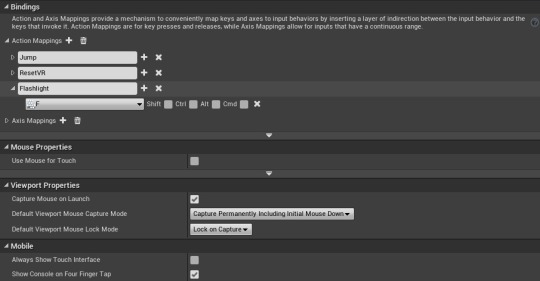
Next, I added a spotlight component to the character viewport and attached it to the follow camera. I then set the flashlight to switch on and off with a FlipFlop node which alternates between both input A and B, starting with A, which enables and disables the visibility of the spotlight component.
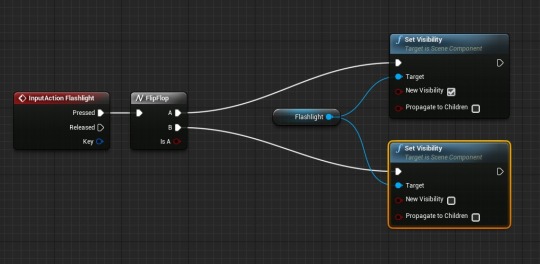
Below you can see the flashlight both deactivated and activated. Finer details of this component such as the intensity and the attenuation radius can be easily altered at a later date if need be.


Next, I decided to add head bobbing to my level as I want to make the characters movement seem more realistic when said character is moving. I did this by creating a camera shake blueprint which I combined with the existing movement input.
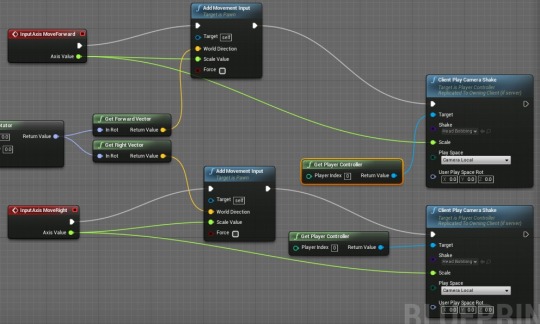
I am happy with my results, though I may alter the severity of the headbobbing at a later date, dependent on feedback.
Next, I am going to add item inspection to my level, to do this I will be using guides found on YouTube, outside of University I find that this is my most preferred method of learning how to blueprint. The series of videos I am using to create my item inspection is titled Unreal Engine 4 - Item Inspection created by Titanic Games, I will not be going too in depth in my blog regarding how I go about creating this mechanic, as it is quite a lengthy process and it can be reviewed in the series by Titanic Games.
I have now completed the previously mentioned step, below is a screenshot of me inspecting a simple cube, it is rotated and triggers a depth of field post-processing effect, the object also returns to its original position upon ending inspection which is triggered currently, by the E key.

Next, I am going to begin white boxing the actual confines for where the gameplay will take place. I am going to create a simple corridor with a doorway of which I will duplicate as many times as needed, laying the corridors in a maze-like fashion.
To ensure I am using apropriate scale, I set both Maya and UE4 to scale in units of centimetres, meaning I can easily create realistically scaled corridors that merge well together. For the time being, I am using measurements from my own home, though I do not have access to corridors that I would like to emulate in my level, it will help me work with a realistic sense of scale, particularly when it comes to the door to wall height and width ratio.
Below are the measurements I will use to aid me in the whiteboxing of my level:
Door height: 196cm
Doorframe height 203cm
Door Width 75.5cm
Doorframe width 88cm
Wall/skirting height 244cm
Skirting height 10cm
Ceiling coving height n/a, though I would like to add ceiling coving to my corridors.
Wall depth 12cm
The only measurements I don’t have are for the length of each corridor, I will base this off playtesting.
Using these measurements, I have created a very simple corridor with doorways at either end along with two other doors opposite each other about midway up the corridor. I have connected several of these corridors together, added a ceiling and floor and I am happy with what I am seeing so far, currently the flashlight needs to be utilised as other than the light coming from the currently empty doorways leading to the outside game world, there are no other sources of light, though this appears to be a satisfying result, as it adds a suspenseful atmosphere to the level, however basic it may be at this point.
Upon a quick playtest, everything seems to be more than satisfactory, though the run cycle seems a little misplaced, I would like to only allow the player to walk through the level, adding more suspense to the gameplay and an eventual desire to explore their surroundings, as currently my initial thought when launching this level in its current state, is to run as fast as I can through the level in order to escape the maze-like confines.
Below are some screenshots of the level in its current state.
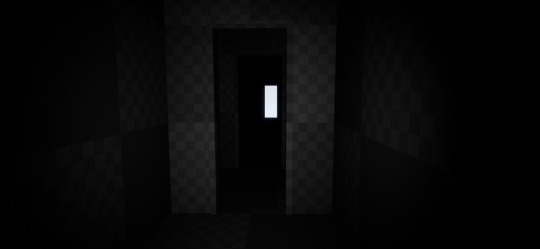
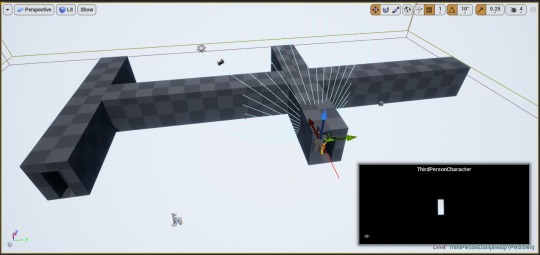
After some help from a fellow student, Andrew Speed, I was able to locate the walk speed setting in the character blueprint, I set this to 200 for now, which seems an appropriate speed, aiding in the suspenseful feel I want for my level.
The next steps I feel are necessary for this level, are implementing doors with open and close animations, adding footstep sounds and creating a flickering light source which I will be able to replicate throughout the level. I will start with the flickering light which I will create using a tutorial named Unreal Engine 4 Tutorial: Horror Game - Part 11 "Flickering Light", created by YouTuber MrFantasticGhost.
As you can see below, I have achieved my goal of creating a flickering light source, something I will easily be able to replicate at a later date.

I have now added animated doors which open with the E key, below is a video showcasing my current progress. As the doors are now triggered by the E key, I have changed the inspection key to R, though I am likely to change this at a later date, I have yet to look into how to utilize the same key for multiple functions.
youtube
I will now develop the game area further according to my own planning. The next implementations will include jumps scares, music, ambient sounds and idle animated characters visible through keyholes.
My next step is whiteboxing the entirety of the level according to the following layout plan.
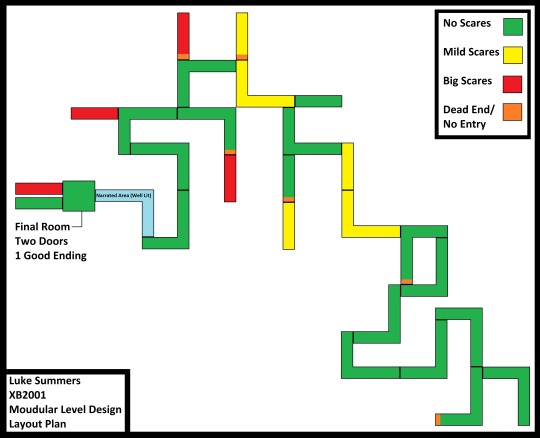
Before constructing the confines of the actual gameplay, I am fist going to alter the player character. I am going to change the player character to one I have retrieved from Mixamo, along with an idle animation and a walking animation.
After downloading the animations and character from Mixamo, I created a blendspace within UE4, which is basically a way of merging the idle and walking animations, meaning the player will transition from an idle stance into a walking animation smoothly.

Then I created the animation blueprint, which directly connects the animation to the payer controller and allows for a smooth speed transition between animations.
Below is the anim graph for the animation blueprint:

Below is the event graph for the animation blueprint:
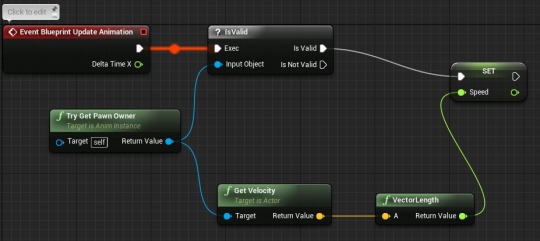
I then attached the camera to the character mesh, socketed to the head as I have previously done to create a true first-person camera, and I am happy with the outcome.

On the Mixamo website, I altered the walk animation so the right arm is extended and the palm is open in a manner that would be suitable for holding a mobile phone, which I would like to use as a torch, as opposed to my previous efforts where a torch would emanate from the player characters head.
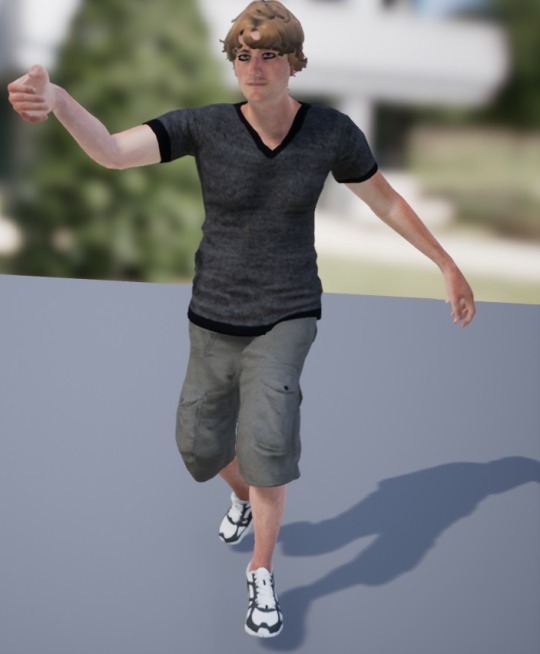
Now, I will white box the entire playable area using a modular kit I created for 3D module XB2002. In its current state, the modular kit is simply made up of various flat walls and one wall with a doorway, I am going to keep these models simple for the time being, as I can add more detail to them at a later date and easily replace the existing models in UE4 without altering their position within the 3D space.
As you can see below, I have begun laying out my modular assets according to my planning. I have also added doors and doorframes to doorways and I have replicated the flickering light asset blueprint I previously created appropriately throughout the confines.
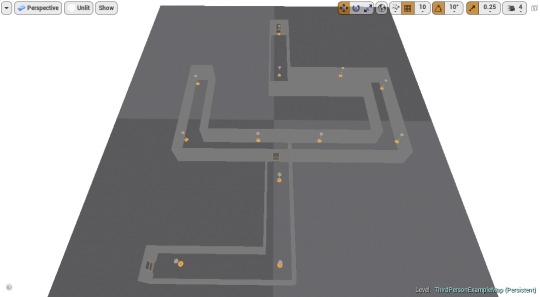
Below is another screenshot of the layout in progress.
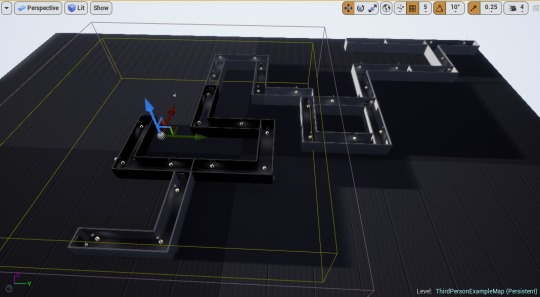
As you can see below, I have now laid out the majority of the confines.
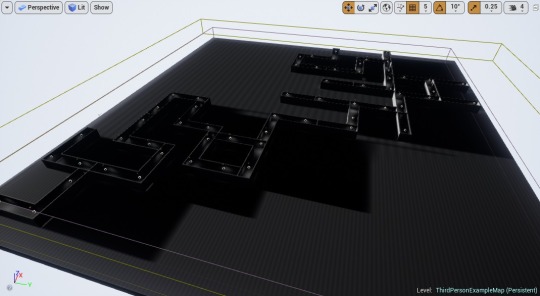
Next, I need to begin implementing scares into my game, which means I need to plan out exactly what type of scares occur in which corridor. I have previously identified where I would like different levels of scares to occur, though I have yet to specify what exactly those scares consist of.
I have created a new layout plan that details the exact location of all 9 scares that I will be implementing.
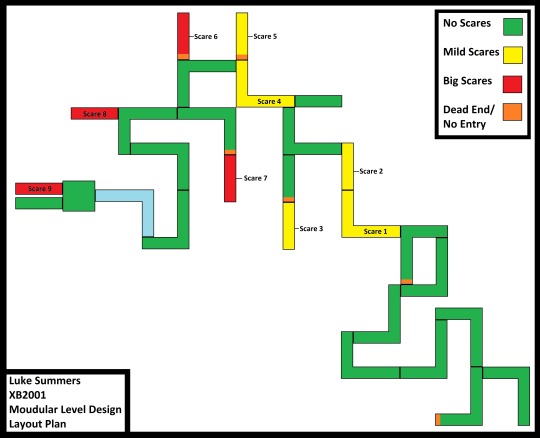
Scares
My game will consist of 9 scares, gradually increasing in intensity as the player progresses through the confines.
Scare 1 - Scare 1 will be an audible scare, when the player steps into the room, they will hear a loud sound, perhaps a scream or the roar of an unnatural being.
Scare 2 - Upon opening the door to the highlighted corridor, the player will trigger an event in which a character runs towards the next corridor, though when the player turns into the next corridor, the character will not be present.
Scare 3 - Scare 3 exists within a corridor with no entrance, this scare will consist of numerous idle beings and 1 being appearing to feast on a lifeless character.
Happy with these ideas, I will now go on to work on these first 3 scares, beginning with scare 1.
Implementing Scare 1
This particular scare is relatively simple, I need to set up a trigger for the player to activate, which will trigger an audio file to play upon activation.
The sound I am using for this scare is from Freesound and can be found at the following link.
https://freesound.org/people/ngrib/sounds/381951/
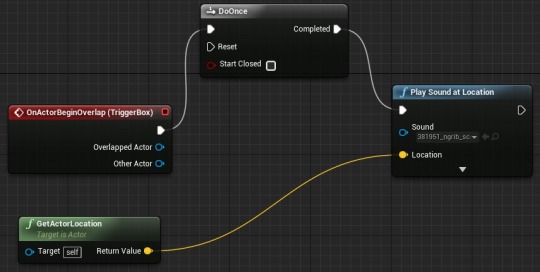
This scare is now functioning as intended, I added a “DoOnce” node, to quickly alter the blueprint to only trigger the sound once, as upon playtesting I noticed that it could be triggered indefinitely.
Implementing Scare 3
This scare is implemented using character models and animations from Mixamo, I have downloaded several zombie characters models along with idle animations which loop indefinitely, another zombie has a biting animation and I intend to have another character appearing to be fed upon.
Below is an event which triggers a cinematic in which a zombie character stands up in front of the player and a sound is played. This cinematic was created by using matinee and you can see how it is set up in the second following image.
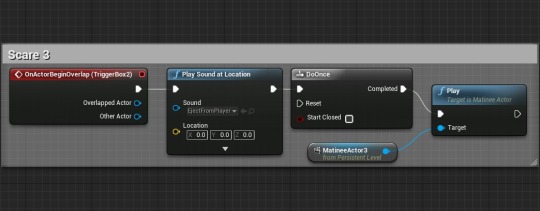
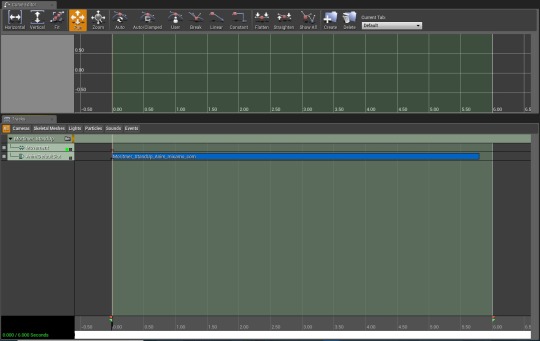
The following is an image taken from my game in the perspective viewport, visible are 4 zombie characters, all of which have idle animations.
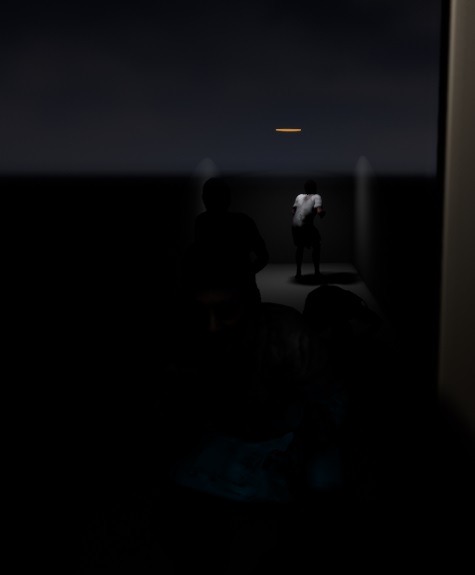
Implementing Scare 2
As with scare 3, for this scare, I need to set up a matinee cinematic in which an animation of a character is triggered. The animated character will be the same character visible at the forefront of the image above.
Below is the blueprint for this scare. As you can see, the matinee which consists of the running animation is triggered once to play and after a 2-second delay, the running actor is destroyed, meaning no traces of the character will be found immediately around the corner.

For this scare to function as I intend, I have made an adjustment to the scale of the playable confines, adding an extra corridor for the running character to emerge from.
Before

After
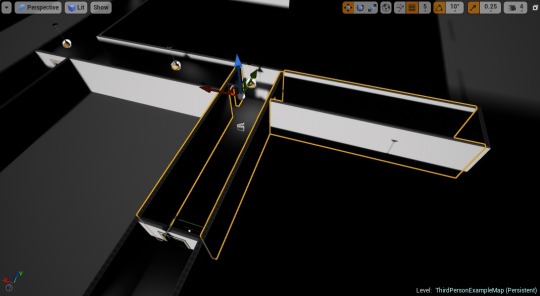
This scare is now complete.
Lighting and Post-processing
Lighting
Before continuing with implementing any mechanics and animation, I am going to alter lighting, to ensure my game looks as good as possible, even in its current state.
The following are steps I have taken to optimise the quality of lighting in my game:
Added directional light
Added atmospheric fog
Connected directional light to atmospheric fog, directional light can now alter the position of sun disk.

Altered cascaded shadow maps - First I altered the dynamic shadow distance which determines how far ahead lighting and shadows are calculated with the results visible, measured from the camera. At first, this was set to 500 units, meaning that light would appear cut off even at a very close distance as you can see in the first following image. In the second following image, with the dynamic shadow distance set to 2000, no lighting appears cut off though lighting calculations do not continue to stress the system far beyond the confines unnecessarily as you can see in the second following image.
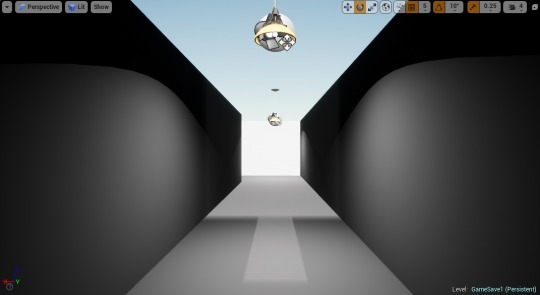
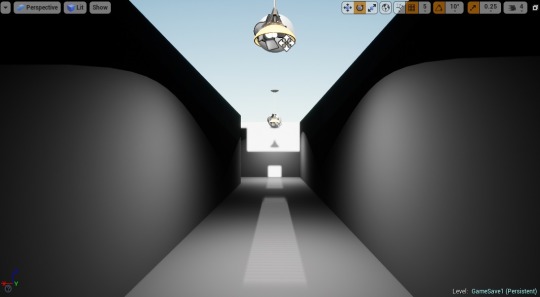
Added lightmass importance volume, concentrating the area that requires the highest quality lighting.
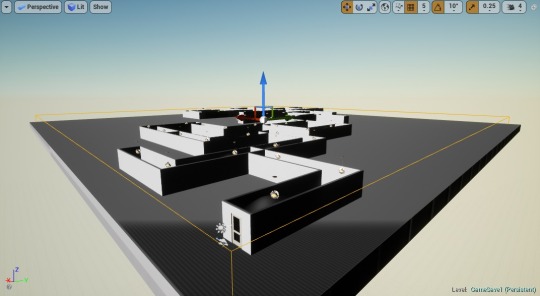
Altered flickering lights attenuation radius and outer cone angle.
Post-processing
Added post process volume
Added vignette effect, set intensity to 1 - I added this effect and set it to 1 units as I like the way it soaks up some of the more intense lighting and blends it towards the edges of the screen.
Added scene tint (may be temporary dependant on feedback)
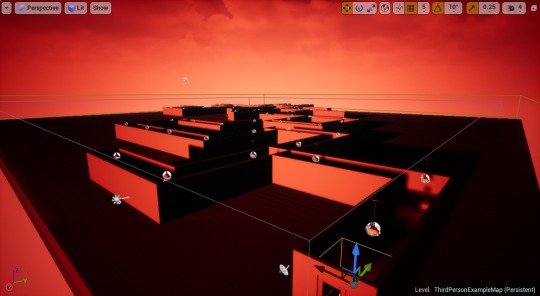
Upon review, I have decided neither implemented post-processing effects seem necessary, at least at this current stage, they actually seem to make the 2 visual scares far less impactful at this moment in time.
One quick change I made was the first audible scare, I changed the sound file to the one available at the following link, I have found this sound to be more effective and natural than the previous audio file.
https://freesound.org/people/josepharaoh99/sounds/390959/
I then added the following audio file to the first visual scare, far more appropriate than the placeholder.
https://freesound.org/people/SirBedlam/sounds/393824/
For the second visual scare, I added a sound cue that is only audible when the player is st a set distance, meaning the closer the player is to scare 3, the louder the sound will be.
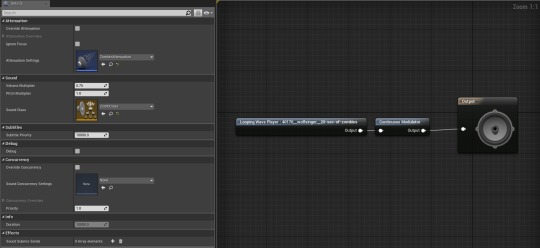
Before continuing with the mechanics and animations for my game, I am going to focus on my work in the XB2002 module, which I will be merging with this project. I will return to this blog when I have game ready modular assets, along with 3D prop assets.
Alteration to layout
Whilst laying out my new modular pieces, I made an amendment to the structure of the confines, juts before scare 1 there was a left turning corridor, it has been replaced with a straight corridor to avoid colliding with other geometry, below is the updated plan.

Further alterations to layout, alterations made due to time constraints, I decided to focus more on the visual aspect of my game, creating models and focusing on realistic lighting as you can see below, along with the new layout/progression diagram.
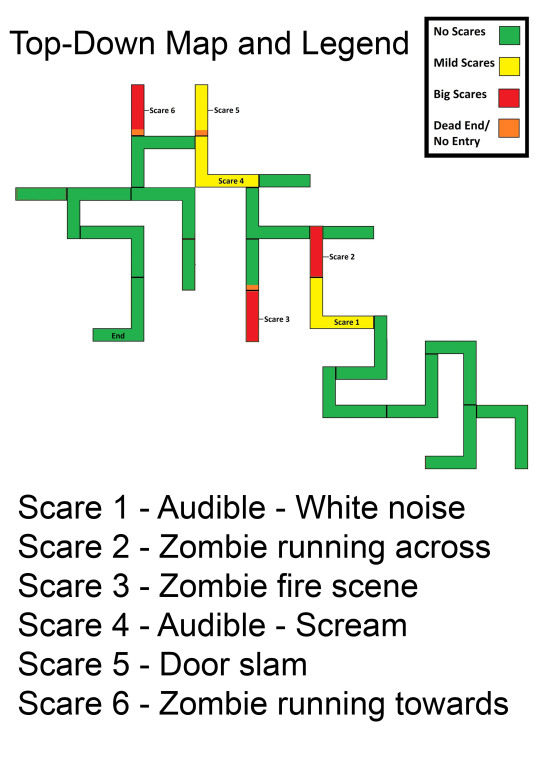

I have now completed my game and I am happy with my outcome.
0 notes